


NC State University
Raleigh, NC
Summer 2024
PREPARED FOR: PREPARED BY:







NC State University
Raleigh, NC
Summer 2024
PREPARED FOR: PREPARED BY:



Jude DesNoyer - Director, Centennial Campus Placemaking
Nathan Hostetter - Assistant Professor NC State, Assistant Unit Leader –NC Cooperative Fish and Wildlife Research
Tom Skolnicki, RLA - Director, Land Planning
Alicia Knight - Associate Vice Chancellor
Chris Ross - Director, Asset Management


Activate Lake Raleigh serves as a blueprint to further elevate the Lake Raleigh area into a natural destination that is vibrant, active, and accessible to members of the University and Raleigh communities. The plan provides an analysis of opportunities and strategies for how to best utilize this valuable amenity to further the mission, vision, and goals of NC State and its Centennial Campus.
IN THIS CHAPTER
1.1 Background
1.2 Project Goals
1.3 Planning Process
1.4 Plan Organization
The Lake Raleigh area is a sprawling oasis that sits in the heart of NC State’s Centennial Campus, less than three miles from downtown Raleigh. The 75-acre lake, the 96 acres of protected forest in Lake Raleigh Woods, and the natural interstitial spaces offer opportunities for outdoor exploration, including hiking, biking, picnics, disc golf, fishing, and non-motorized boating.
As part of its long-term vision, the NC State Real Estate and Development Office identified the need to develop a plan to activate and enhance Lake Raleigh and the surrounding University property based on university goals and stakeholder input.
The vision is to transform the Lake Raleigh area into a more accessible and attractive natural destination that includes a diversified mix of University programming, a new home for research and educational interests, activities that promote physical and mental wellness, and a place for relaxation.
HI s T or Y o F L ake ra L e I g H
Lands in and around the area of Lake Raleigh were developed in the mid-1800s to support the former Dorothea Dix State Hospital. The grounds were used for the hospital’s farms, orchards, and livestock. In 1900, an earthen dam was constructed along Walnut Creek to create Lake Raleigh, and it served as the City’s primary water supply reservoir until the construction of Lake Johnson in 1927. In 1919, the dam was rebuilt to expand the lake surface area, and farming and residential development occurred north of the lake throughout the 1900s.
In the mid-1980s, Lake Raleigh was no longer used as a municipal water source, and approximately 835 acres of the hospital property including Lake Raleigh was transferred to North Carolina State University for the creation of Centennial Campus. In 1996, the dam failed as a result of Hurricane Fran, and the reservoir drained. In the spring of 2001, a new dam was completed, and the lake was dredged.
Lake Raleigh Woods, an approximately 96-acre forested area located south and west of Lake Raleigh on Centennial Campus, is designated by NC State as one of the ten Hallowed Places on campus. The concept began with a proposal submitted in May 2005 by NC State students, faculty, and staff for the designation of the area as an education and biodiversity reserve of significant local and regional importance. In 2006, an environmental assessment was completed, and in 2010 a general management plan was produced.
Formal trail development occurred at Lake Raleigh Woods from March 2021 to December 2023. The Lake Raleigh Woods Trail Plan (2019) provided an analysis of the existing informal trail system, general guidelines for trail design and construction, and trail alignment recommendations. The Lake Raleigh Loop Trail Study (2023) examined the feasibility of creating a continuous loop trail around Lake Raleigh.
Most recently, the development of NC State’s Centennial Campus has allowed the Lake Raleigh vicinity to continue to evolve.
nc s TaT e un IV ers ITY cen T enn I a L ca MP us
The NC State Centennial Campus was established in 1984 with a vision for a new kind of campus focusing on research, innovation and public-private partnerships. The campus is close to downtown Raleigh, Raleigh-Durham International Airport, Dorothea Dix Park, the State Farmers Market, and major highways, including Interstates 40 and 440.
The growing campus community blends academic and office facilities, residential living, and recreation opportunities, including restaurants, a hotel, and public golf course all situated near Lake Raleigh.
In addition to recreation opportunities, such as natural surface trails and disc golf, the campus offers year-round events and programming – including outdoor movies and concerts, food truck rodeos, research talks, races, and outdoor skills classes.
The Lake Raleigh Loop Trail Study (2023) identifies a conceptual alignment that connects the existing Lakeview Trail from its northern and eastern ends to the Walnut Creek Trail to create a loop trail around Lake Raleigh.






The Project Committee identified five primary goals for Activate Lake Raleigh:
co MM un ITY engage M en T
Engage University faculty, staff, students, partners, and community members to identify strategies, recreation and programming opportunities, research and education integration, and potential partnerships that will activate the Lake Raleigh area.
a W areness
Create a unique identity for the Lake Raleigh area and increase awareness of nearby amenities that serve the NC State community, residents, and visitors.
ca MP us connec TI ons
Identify opportunities to physically and visually connect Lake Raleigh to Centennial Campus, Main Campus, and the surrounding community.
en VI ron M en Ta L s T e W ards HIP
Ensure that all recommendations preserve the natural assets of the Lake Raleigh area and the designation of Lake Raleigh Woods as a Hallowed Place is honored and maintained.
e XP er I ence
Create a vibrant and welcoming experience that provides the NC State University community, residents, and visitors with opportunities for recreation, physical, mental, and social wellness, a diversified mix of programming, and a home for research and education opportunities.
Activate Lake Raleigh is the result of over 10 months of data gathering, community engagement, stakeholder meetings, interviews, analysis, and field work. This planning process featured four major phases including:

PH ase 1: d I rec TI on se TTI ng + P ro J ec T L aunc H
se PT e MB er 2023 – no V e MB er 2023
The consultant team conducted a directionsetting meeting with the Project Committee to establish project goals and timelines. Marketing materials were created to inform the University community and the public about the planning process and encourage participation.



PH ase 2: researc H + ana LY s I s
se PT e MB er 2023 – no V e MB er 2023
The consultant team conducted a site visit and field analysis to understand key opportunities and constraints and reviewed previous studies that might have implications on the Activate Lake Raleigh plan.

PH ase 3: s Take H o L der + co MM un ITY engage M en T
se PT e MB er 2023 – M arc H 2024
Input was collected from faculty, staff, students, and community members via an online survey. Stakeholder groups and community members were engaged through focus group meetings, personal interviews, and public engagement sessions.



PH ase 4: PL an de V e L o PM en T + FI na L PL an P re ParaTI on M arc H 2024 – augus T 2024
The consultant team created a plan framework that featured preliminary strategies to activate the Lake Raleigh area. With direction from the Project Committee, the consultant team prepared the final plan that summarizes and incorporates community input, aligns with the strategic goals of the University, and provides activation recommendations and strategies for plan implementation.
Activate Lake Raleigh is organized into five major chapters as outlined below:
1. Background and Purpose
2. Discovery and Site Analysis
3. Community Engagement
4. Activation Strategies
5. Implementation

c H a PT er 1: B ackground and P ur P ose
The current chapter, which outlines the plan’s purpose, goals, process, and organization.
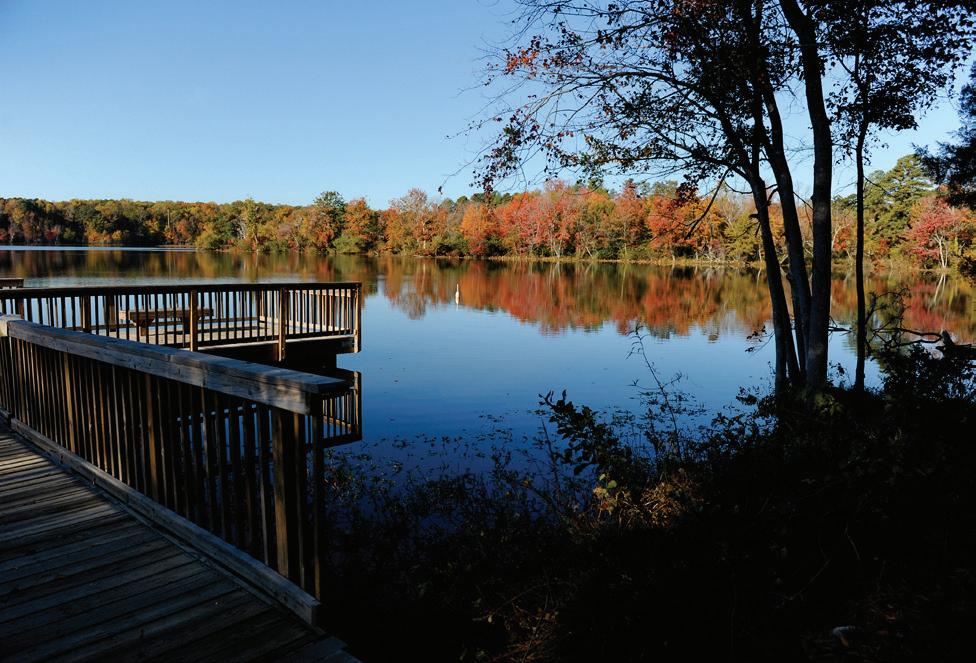
c H a PT er 2: d I sco V er Y and s IT e ana LY s I s
The activation area, demographics, relevant previous studies, and the asset and programming inventory are outlined in this chapter.

c H a PT er 3: co MM un ITY engage M en T
This chapter describes the community engagement process, including the methods used, the groups that were engaged, and the results of the community survey. The chapter culminates with the Activation Focus Areas that were identified during the process and creates the framework for the recommendations in Chapter 4.
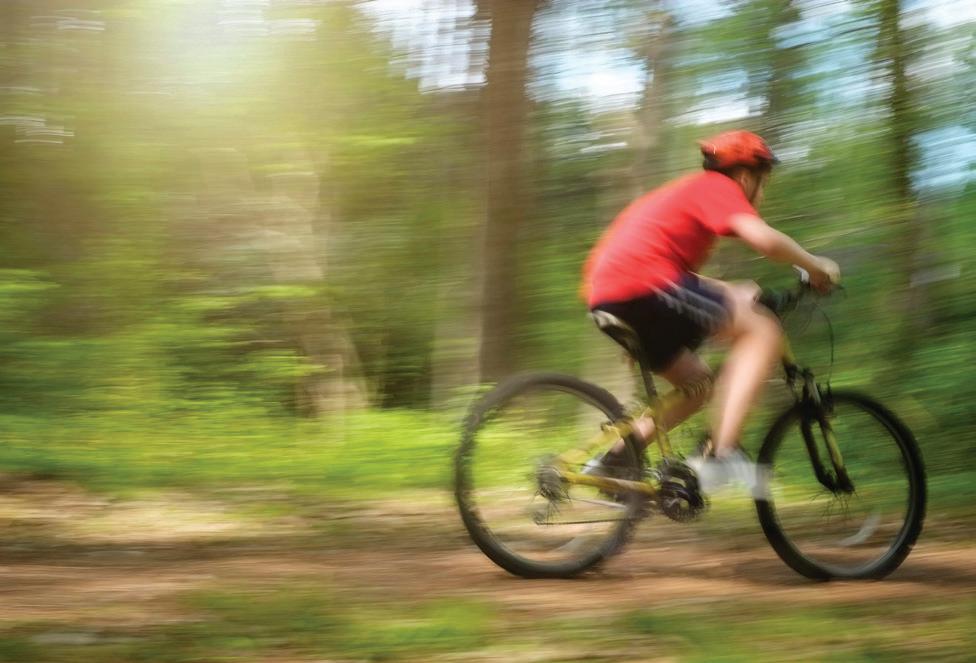
c H a PT er 4: ac TIV aTI on s T raT eg I es
This chapter is organized according to the five Activation Focus Areas as identified during the planning process: 1) Connectivity 2) Environmental Stewardship 3) Health + Wellness 4) Education + Research 5) Arts + Entertainment.
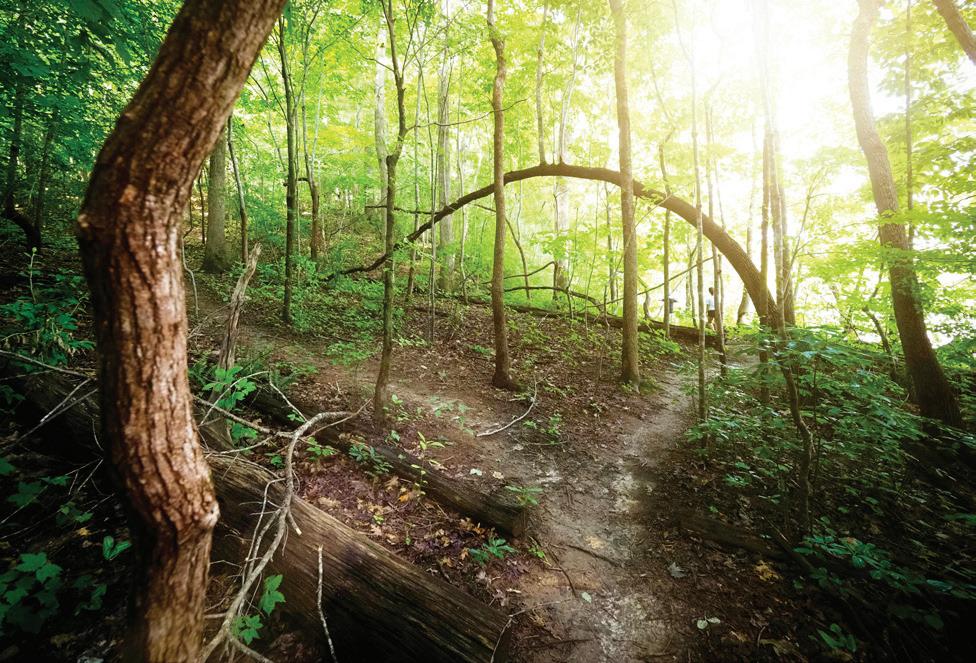
c H a PT er 5: IMPL e M en TaTI on
This chapter presents general recommendations for implementing Activate Lake Raleigh and the list of activation initiatives that should be prioritized for near-term implementation.
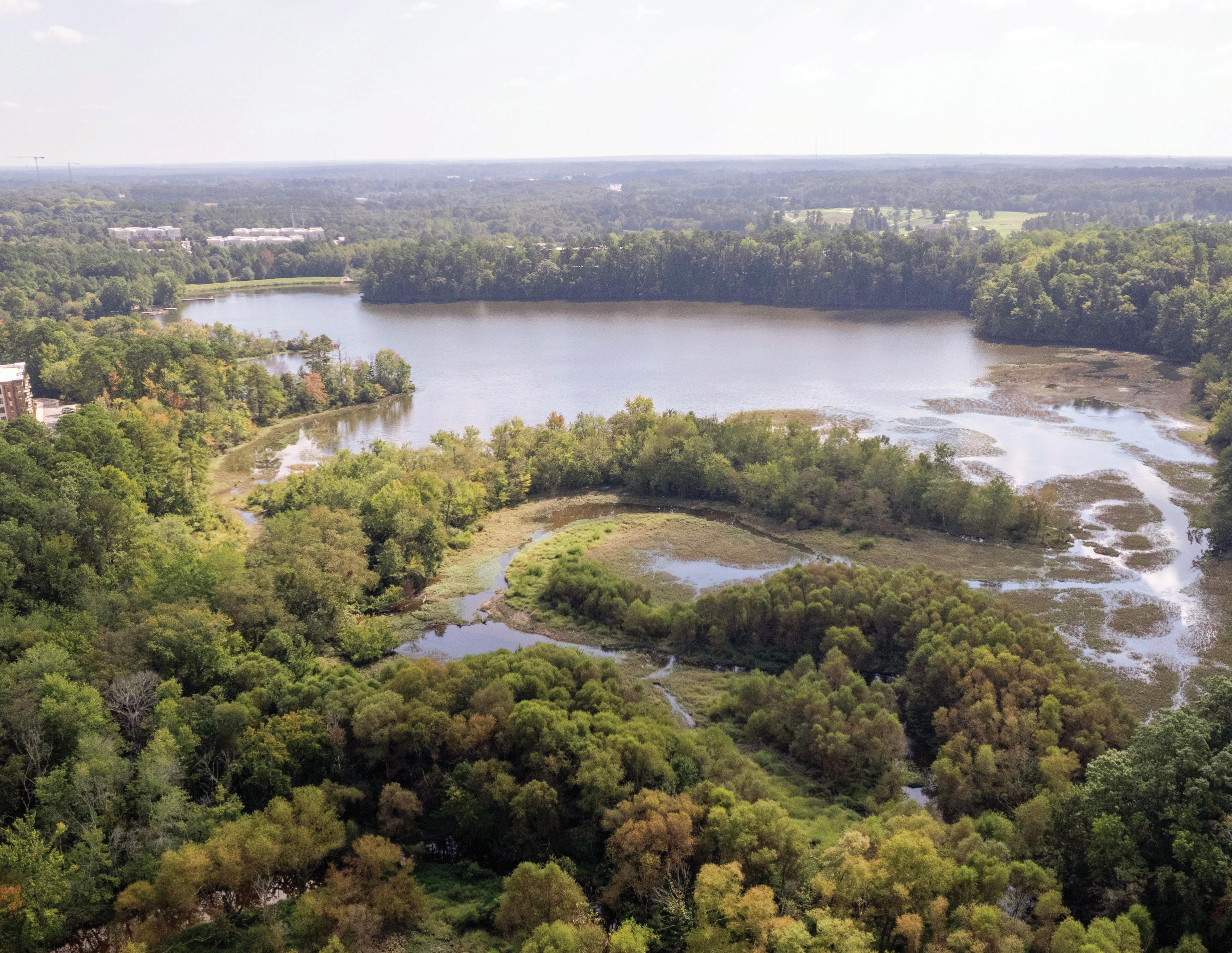

This chapter examines the activation area, demographics, relevant previous studies that have occurred at or near Lake Raleigh and Centennial Campus, and the current asset and programming inventory.
IN THIS CHAPTER
2.1 Activation Area
2.2 Demographics
2.3 Previous Studies
2.4 Asset and Programming Inventory
The Lake Raleigh area is located within NC State’s Centennial Campus precinct in southwest Raleigh, just north of I-40 and east of I-440. (See Map 01: Vicinity Map below.)
Centennial Campus is bounded by I-40 to the south, Trailwood Drive and Avent Ferry Road to the west and northwest, Centennial Parkway and Bilyeu Street to the north and northeast, and Dix Park and Lake Wheeler Road to the south and east.
Lake Raleigh is centrally located on Centennial Campus and nestled among both institutional and public-private partnership developments. To the north of the lake, there are academic buildings as well as office buildings with private commercial tenants. The StateView Hotel and the Alumni Center are on the southern shore of the lake. To the northwest and east of the lake, there is residential development, including the North Shore and The Greens apartment complexes.
Lake Raleigh Woods is located southwest of the lake. The Centennial Campus disc golf course is northeast of the lake, while the Lonnie Poole Golf Course is located to the south. (See Map 02: Context Map, page right.)
There are three access points and parking areas for the Lake Raleigh area, including Main Campus Drive, the Park Alumni Center, and the Centennial Campus Middle School.
The Lake Raleigh area is part of a larger network of green space, parks, lakes, and outdoor recreation opportunities near downtown Raleigh. Nearby lakes and parks include Lake Johnson to the west, Pullen Park to the northeast, and the 308-acre Dorothea Dix Park to the east, which is being transformed into a unique urban park destination in the heart of Raleigh. The Walnut Creek Trail, which is part of the Capital Area Greenway System, runs along the north side of Lake Raleigh and connects Lake Raleigh area to Lake Johnson as well as Dorothea Dix Park and Pullen Park via the Rocky Branch Trail.
NC State Main Campus
NC State Centennial Campus
City of Raleigh Parks
Activate Lake Raleigh Study Area
Lake Raleigh Woods
Greenway/Bike Paths



As a R1 Research Institution, NC State is home to a large and diverse population with over 37,800 students, 2,400 faculty, and 7,100 staff living, learning, and working on campus.
Within NC State, Centennial Campus brings together a unique community including NC State students, faculty, staff, industry partners, and residents. On Centennial Campus, there are over 75 University academic departments, institutes, and centers, including the College of Engineering, Wilson College of Textiles, and the James B. Hunt Jr. Library.
Centennial Campus is also home to over 70 industry, government, and nonprofit partners with thousands of employees who work on campus. In addition, private residents live on Centennial Campus in apartments, townhomes, and condominiums. The StateView Hotel and its restaurant, the Flask & Beaker, and the Park Alumni Center with its restaurant, the Lakeside Restaurant, are also located on Centennial Campus on the south shore of Lake Raleigh.
With its close proximity to downtown Raleigh, the Walnut Creek Trail, Dix Park, and Lake Johnson – many community members from the Greater Raleigh Area visit Centennial Campus to access the lake, trail system, and community events.


This section provides a summary of previous studies produced for the University and surrounding area, including physical master plans, strategic plans, and management plans. These plans are organized according to their date of completion, ranging from 2005 to 2023.
In 2023, NC State adopted their most recent physical master plan. The Plan identifies the facilities, open spaces and campus infrastructure needed to fulfill the University’s mission and meet current and future challenges.

One of the main focuses of the Plan is campus connectivity, mentioning specifically connectivity to Lake Raleigh from other campus precincts. The plan splits campus into five campus precincts. The Centennial Campus precinct section illustrates the potential for better connectivity and access to Lake Raleigh through improvements to the pedestrian and open space network.
L ake ra L e I g H L oo P T ra IL s T ud Y (2023)
The Lake Raleigh Loop Trail Study identifies a conceptual alignment that connects the existing Lakeview Trail from its northern and eastern ends to the Walnut Creek Trail to create a loop trail around Lake Raleigh. The study also serves as an update to the Lake Raleigh Woods Trail Plan produced in December of 2019.
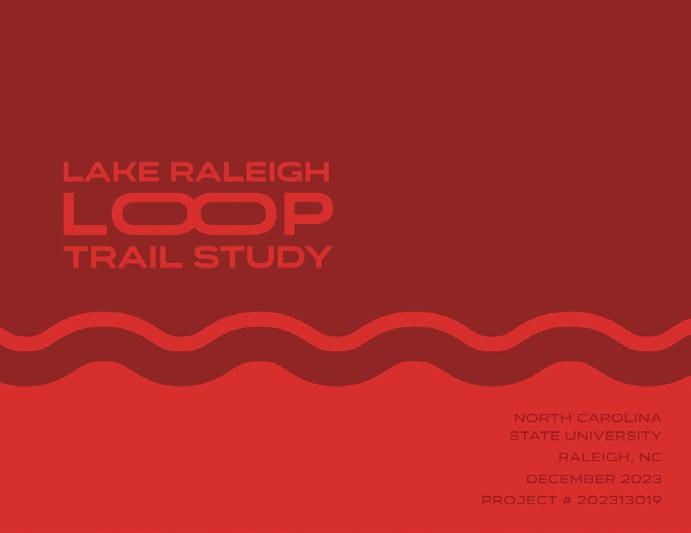
ca PITa L area green W aY M as T er PL an (2022)
This City of Raleigh plan inventories the strengths and weaknesses of the greenway system in regards to amenities, safety, equity, and connectivity in the Raleigh Area followed by recommendations, including specific recommendations for improvements along the NC State campus section of the Walnut Creek Trail.

W o LFPack 2030 P o W er I ng TH e e XT raord I nar Y (2021)
Wolfpack 2030 is NC State’s 2021-2030 Strategic Plan that was endorsed by the NC State Board of Trustees on April 16, 2021. The plan discusses the University’s vision and core values and describes the Strategic Plan goals. All of the recommendations in the Activate Lake Raleigh Plan are guided by the values and goals outlined in the Strategic Plan.

L ake ra L e I g H W oods T ra IL PL an (2019)
This plan was developed as a supplement to the Lake Raleigh Woods General Management Plan, which provided a detailed site analysis and recommendations for enhancing protection as well as recreational and educational use to the 96-acres of NC State property. The Trail Plan analyzes the existing trial system and gives general guidelines and recommendations for trail design and construction. Target areas for recommendations include trailheads, mountain bike loops, hiking trails, and trail system management.

genera L M anage M en T PL an F or L ake ra L e I g H W oods (2016)
This forest management plan provides suggestions for facility and natural resource management practices. Included in the plan are concerns regarding the informal trail network that existed at the time, especially the loop trail around the lake that was heavily eroded. One of the recommendations was to initiate recreation trail/management for Lake Raleigh. They encouraged future trail construction for areas where stream crossings and slopes greater than 10% occur and a resurfacing or rerouting for the loop trail around the Lake.

dra FT en VI ron M en Ta L assess M en T F or TH e P ro P osa L T o es Ta BLI s H L ake ra L e I g H W oods : an educaTI ona L and BI od IV ers ITY naT ura L reser V e aT nor TH caro LI na s TaT e un IV ers ITY (2006)
This draft environmental assessment was prepared by graduate and undergraduate students and accompanies the 2006 proposal to establish Quay Woods. It includes a soil and species inventory as well as potential and probable impacts of the establishment of Quay Woods. The trails as they were in 2006 are mapped in this assessment. They also note the trails on Lake Raleigh that were highly used and social at that time as well as unplanned trails that needed improvement to prevent further degradation.

Q uaY W oods , an educaTI ona L and BI od IV ers ITY naT ura L reser V e aT nor TH caro LI na s TaT e un IV ers ITY (2005)
The proposal lists several value propositions for Quay Woods, including usage as an education resource, biodiversity and sustainability resource, financial asset, and recreation resource.
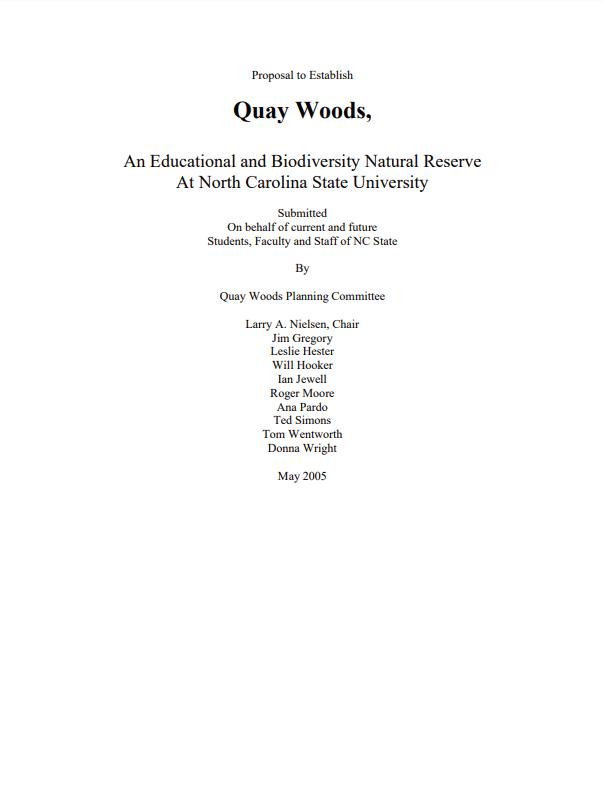
The Lake Raleigh area offers a variety of opportunities for outdoor recreation, including hiking, biking, fishing, nonmotorized boating, and disc golf. The following outdoor recreation assets and opportunities currently exist in the Lake Raleigh area:
• Over four miles of natural surface hiking trails
• Beginner and intermediate natural surface mountain biking trails
• The paved Walnut Creek Trail (part of the Capital Area Greenway System)
• Two fishing piers
• Boat launch for non-motorized watercraft (such as kayak, canoe, or paddleboard)
• Nine-hole Centennial disc golf course
P rogra MMI ng
In addition to the outdoor infrastructure, there is currently a variety of programming offered in or near the Lake Raleigh area including:
• Outdoor concerts and movies
• Guided hikes of Lake Raleigh Woods
• Staff and faculty running club
• Yoga and other wellness classes
• Bike rentals
• Food trucks
• PopUp Pickleball
• NC State Wellness and Recreation student programming
• NC State student experiences
• NC State student- and facultyled research

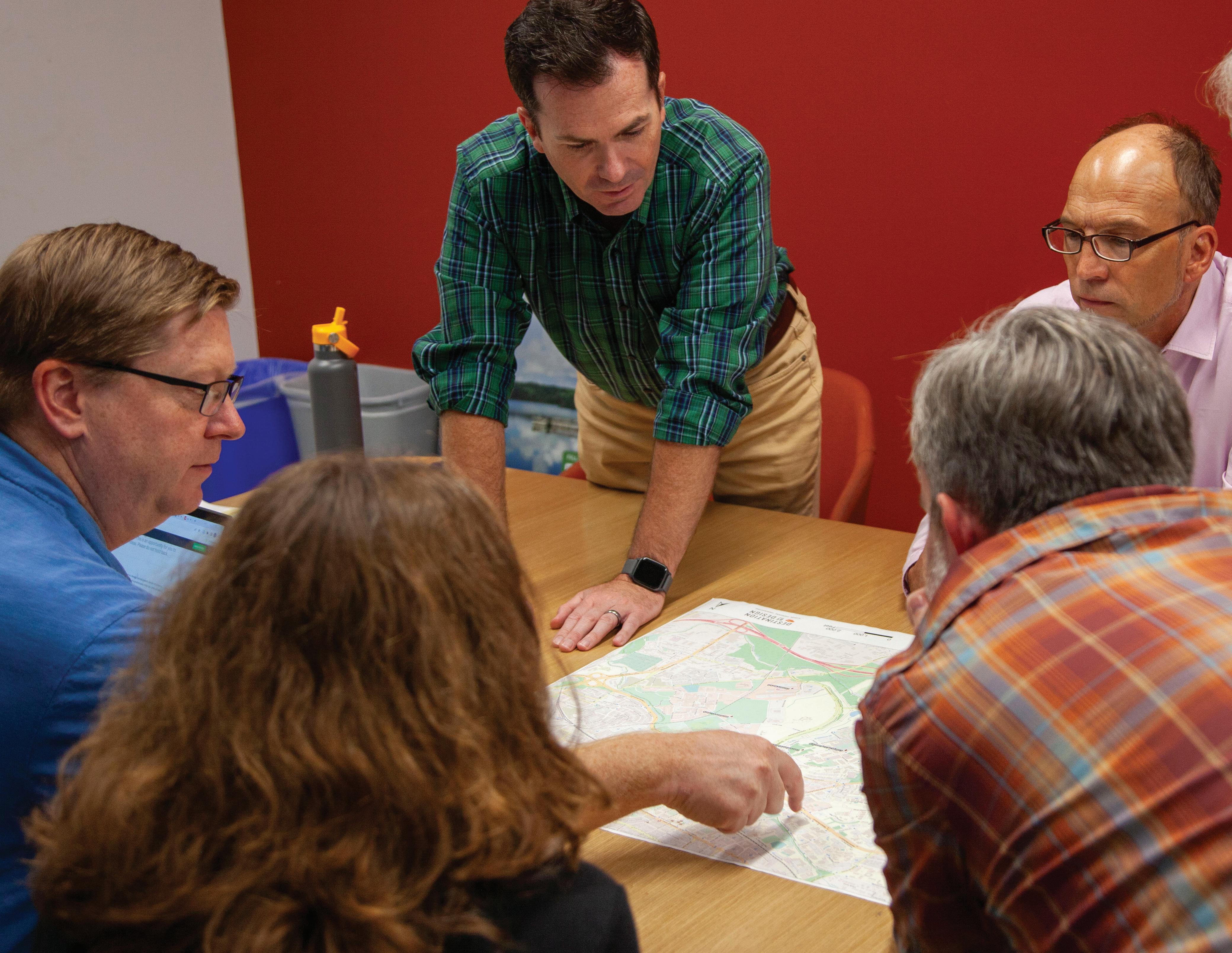

This chapter discusses the primary stakeholders involved in the planning process, methods used for public engagement, and key results from an online survey designed to obtain ideas from a variety of community members. The chapter culminates with the introduction of the five Activation Focus Areas that are used to guide the plan recommendations and implementation strategy.
IN THIS CHAPTER
3.1 Tools of Engagement
3.2 Community Survey
3.3 Focus Groups and Interviews
3.4 Public Engagement
3.5 Activation Focus Areas
Community engagement was an important goal of Activate Lake Raleigh. To raise awareness about the project and invite participation from the key stakeholder groups (NC State faculty/staff and students, Centennial Campus industry partners, and local residents), a variety of marketing materials were created that pointed to the Activate Lake Raleigh community survey via a QR code. Materials included large-scale posters, flyers, yard signs, business cards, and a digital banner on the Lake Raleigh website. Marketing materials were distributed around Centennial Campus and Main Campus, Lake Raleigh, Lake Raleigh Woods trail heads, public locations such as coffee shops and public libraries around Raleigh, through social media channels, and on the radio.



centennial.ncsu.edu/thrive/lake-raleigh

Lake Raleigh rests at the heart of NC State’s Centennial Campus, less than 3 miles from downtown Raleigh. The university needs your help reimaging how the lake and surrounding area can be used by all members of the community.
Our vision is to create a new home for programs ranging from research and education to physical and mental wellness, while maintaining the natural beauty that dominates the landscape.
Activate Lake Raleigh is a community engagement project with the goal to engage faculty, sta , students, and the broader community, to identify strategies that will help enhance and improve Lake Raleigh and the surrounding area.
We hope to bring new and exciting ideas to this area, so please dream big and share your input on how strategies intended to Activate Lake Raleigh should be prioritized.














This section summarizes the results of the Activate Lake Raleigh Community Survey.
An online survey was conducted to obtain ideas from a variety of community members, including local residents, NC State students, faculty and staff, and Centennial Campus industry partners.
The online survey was open from October to December 2023 and was publicized via posters and flyers at Centennial Campus events and buildings, throughout the Lake Raleigh area, Raleigh businesses, email, and social media. The survey received 886 responses.
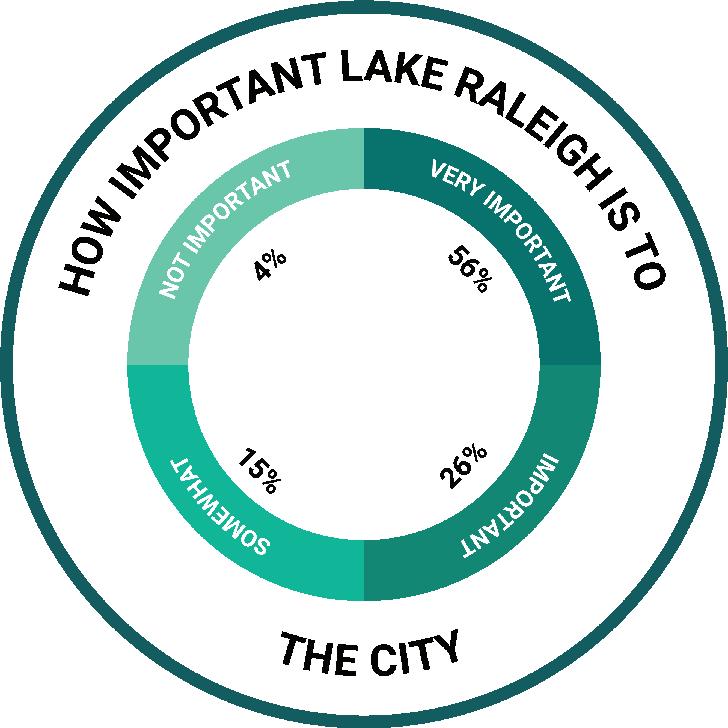

This chapter summarizes stakeholder engagement and input during Focus Group meetings and interviews.
The cornerstone of Activate Lake Raleigh is the engagement of NC State faculty, staff and students, Centennial Campus industry partners, and local community members to identify the strengths and opportunities at Lake Raleigh and to generate bold ideas for how to activate the Lake Raleigh area.
On February 28 and 29, 2024, the consultant team facilitated three focus group meetings. The focus groups consisted of the following themes and participants:
researc H and educaTI on :
Rob Dunn – Sr. Vice Provost, Office of University Interdisciplinary Programs
Gary Blank – Professor, College of Forestry
Mallory Choudoir – Assistant Professor, Microbiology
Erin McKenney – Assistant Professor, Applied Ecology
Ted Simmons – Professor Emeritus, Biological Sciences
Karl Wegmann – Professor, Marine, Earth and Atmospheric Sciences
JoAnn Burkholder - Professor, Applied Ecology
Steve Frank - Professor, Plant Pathology
W e LL ness and recreaTI on :
NC State Wellness and Outdoor Recreation staff, including Mary Barnhart, Katie Birdsall, Eric Hawkes, Erin Heiser, Catherine O’Kane, Alexis Steptoe, Ben Strunk, and Edna Williams.
I ndus T r Y Par T ner - HITac HI:
Employees of a Centennial Campus industry partner, including Pandian Duraisamy, Kim Gervase, Ryan Muzzell, Melissa Smith, Danny Tran.

What do you think is the best use of the Lake Raleigh area based on the needs of the group you represent?
What is your bold idea for Lake Raleigh?
ke Y TakeaWaY s F ro M F ocus grou P s:
• Connect Main Campus to Lake Raleigh via trail/greenway
• Improve trailhead spaces and trail signage (icons to identify trail locations)
• Interpretive signage on trails (biology/ecology)
• Student Union/ Rec Center on Centennial
• Student residential laboratory (ex. Duke)
• Outdoor classrooms (around/near lake)
• Family nature-based programming
• Experiential education
• Treenets
• Zipline across lake
• Fitness stations (ex. Outdoor CrossFit Carmichael Center)
• Bike repair center
• Identify Lake Raleigh trailheads as destinations in mapping apps
• Equipment rental (kayak, canoe, bike)
• E-bikes (rental/share station)
• Lakeside kitchen (awareness/hours of operation)
• Outdoor co-working space
• Solar-powered charging stations
• Hammock grove
• Sustainable/volunteer opportunities for Hitachi and other private tenants
• Management of greenway (safety/operation/maintenance)
• Institute for Emerging Issues at Hunt Library
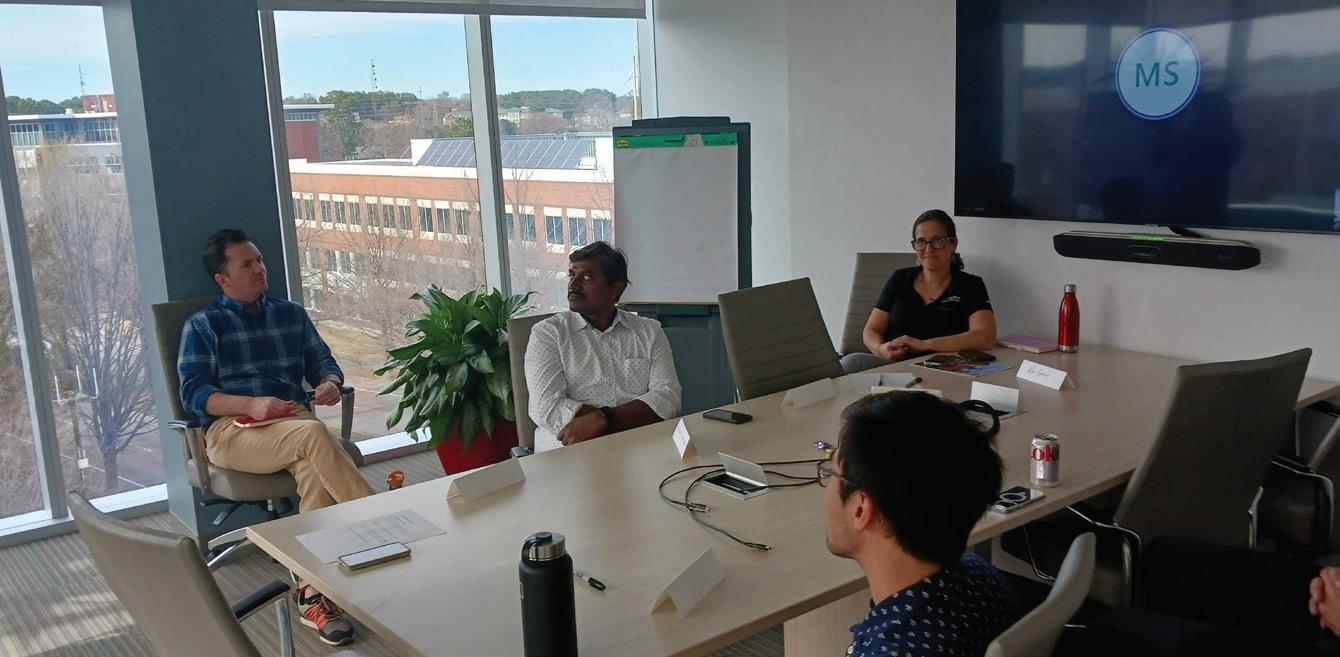
TH e consu LTanT T ea M a L so conducT ed
WITH TH e F o LLo WI ng P eo PL e:
Paul Brown – University Foundations, NC State
Caren Cooper – Citizen Science Director, NC State
Chris Dobek – Assistant Director, Transportation, NC State
Mike Fausnight – Development Director, Real Estate, NC State
Marian Fragola – Director of Community Engagement, University Libraries, NC State
Christopher Galik – Sustainability Professor, Sustainability Council Director, NC State
Tina Govan – Raleigh Resident, Placemaking Studio
Ellia Jones – Student in Parks, Recreation and Tourism , NC State
Dana Magliola – Head Coach, Sailing, NC State
Chuck Millsap – Director of Engagement and Marketing, Great Outdoor Provision Company
Sam Nechvatel – Centennial Campus Private Resident
Catherine Phillips – Director of Operations, Analysis and Planning, Office of Finance and Administration, NC State
Lynn Swank – Landscape Architect, University Capital Projects, NC State
Jory Weintraub – Director of Science Engagement, NC State
This chapter summarizes public engagement and input during community events.
On February 28 and 29, 2024, the consultant team facilitated four public engagement events to gather input and ideas from the community.
The public engagement activities included:
1. “What Would You Like to See at Lake Raleigh?”: Engagement exercise that invited participants to choose the infrastructure improvements and/ or programming they would like to see in the Lake Raleigh area.
2. “Share your Bold Ideas for how to Activate Lake Raleigh”: Opportunity to write-in ideas for infrastructure improvement and/or programing.
3. Community Survey Results: Display Board with community survey results presented as infographics.






TH e P u BLI c engage M en T V enues I nc L uded :
cen T enn I a L ca MP us F ood T ruck rodeo
Set up table and engagement activities during the regularly scheduled Food Truck Rodeo on Main Campus Drive at Centennial Campus. Engagement was primarily with employees of Centennial Campus industry partners and NC State faculty and staff.
d IX Park su MMIT
Participated in the large community event at Dix Park along with the City of Raleigh, the Dix Park Conservancy, and many other organizations. Strong engagement and feedback from Raleigh residents interested in outdoor recreation, green space, and community programming.
s T uden T recreaTI on cen T er
Shared information and engagement activities at the NC State Wellness and Recreation Center during the lunch-time hour. Engagement was primarily with NC State students.
cen T enn I a L ca MP us soc I a L H our
Participated in the regularly scheduled Social Hour. Shared information and gathered feedback through the engagement activities. Engagement was primarily with employees of Centennial Campus industry partners and NC State faculty and staff.
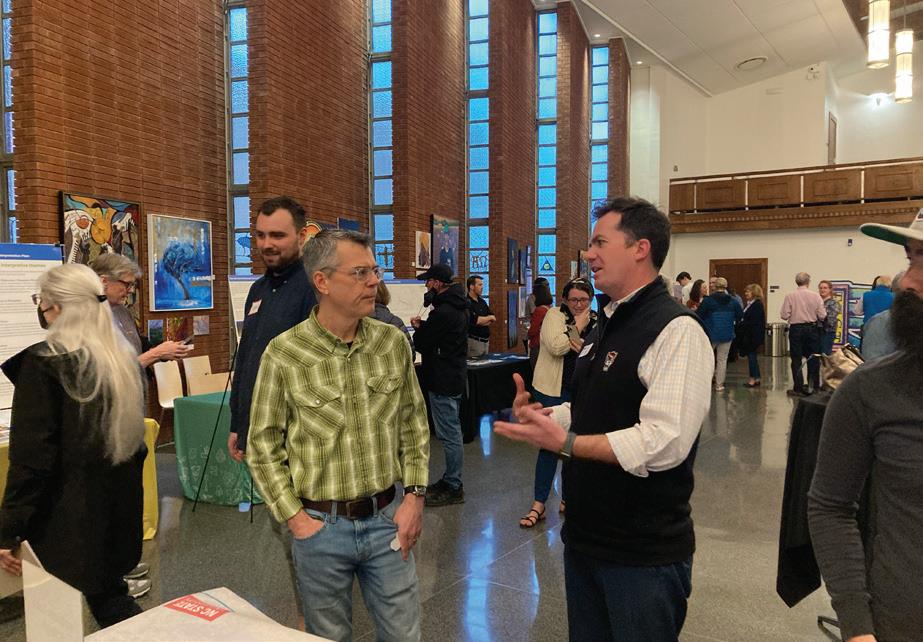
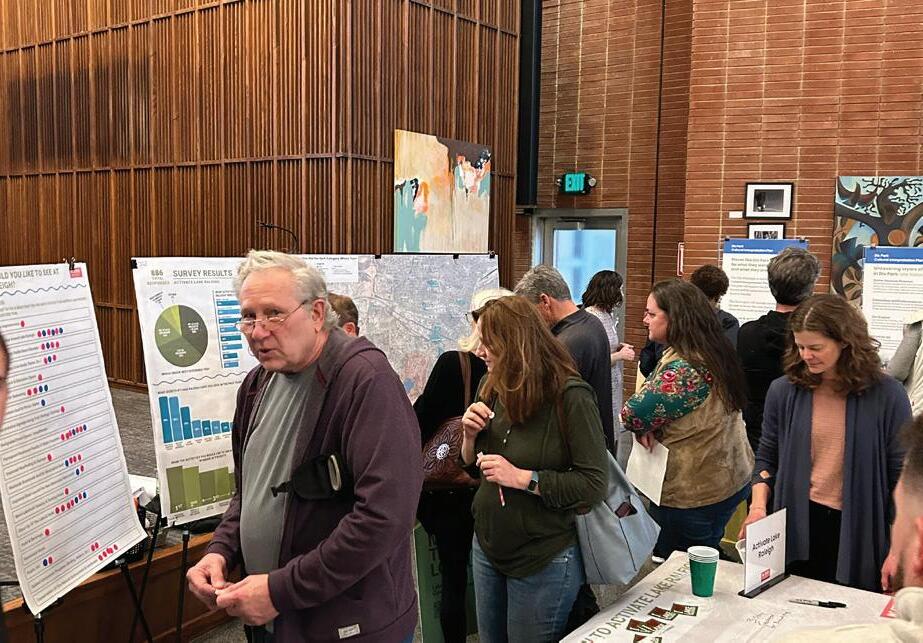
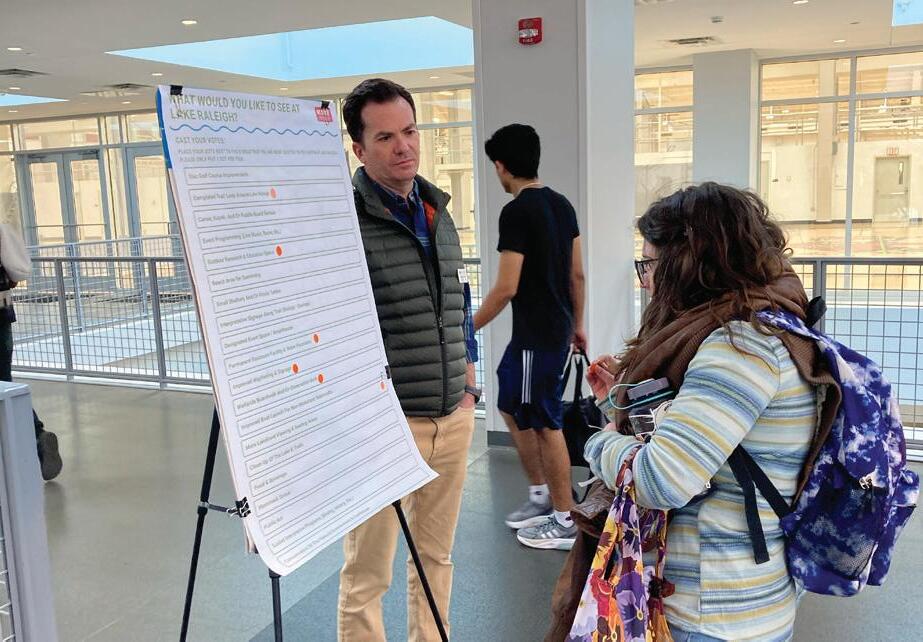
I deas F ro M “ s H are Y our B o L d I deas F or H o W T o ac TIV aT e L ake ra L e I g H” engage M en T ac TIVITY:
• Live bird cam
• Swimming program/lessons
• Opportunities to get in the water
• Three-story treehouse for birdwatching/research
• Secure lockers for kayak/SUPs (personally-owned)
• Walkway from main campus (parking) to the lake
• Pollinator garden
• Family-friendly pump track
• Destination points around the lake for boating/SUP
• Art collective + interactive art museum
• Drum circle space
• Immersive and inclusive playground
• Outdoor workout station (CrossFit, like at Carmichael)
• A flexspace (outdoor/indoor) for NCSU events
• Glamping
• Carnival at Lake Raleigh
• The Retreat at Lake Raleigh
• Floating gardens

• Gear rental of kayaks, canoes, paddleboard, sailboats, and mountain bikes
• Guided interpretive walks (birding, foraging, etc.)
• Destination points around the lake for kayak and paddling
• Beginner classes for kayaking, paddle boarding, sailing, and mountain biking
• Volunteer opportunities to clean up the lake and trails
• Sensory or tranquility garden
• Tree Weaves to relax or play in the tree canopy
• Secure lockers for storing gear (kayaks, paddleboards, bikes)
• More opportunities to participate in citizen science
• Continue with and expand live music events
• Complete the trail around Lake Raleigh
• Permanent amphitheater or event venue
• Install benches along the lakeshore
• Small shelters or picnic areas
• Three-story treehouse for wildlife watching and research
• Fully equipped outdoor classroom
• State of the art outdoor laboratory and research facility
• Create a dedicated hammock grove
• Public art installations throughout the recreation area
• Improve or expand the disc golf course


The Activation Focus Areas provide the framework and rationale for the activation strategies provided in Chapter 4. These themes will help guide decision-makers over the next several years as NC State and its stakeholders implement the vision cast by the Activate Lake Raleigh Plan.
1. Connectivity
2. Environmental Stewardship
3. Health + Wellness
4. Education + Research
5. Arts + Entertainment
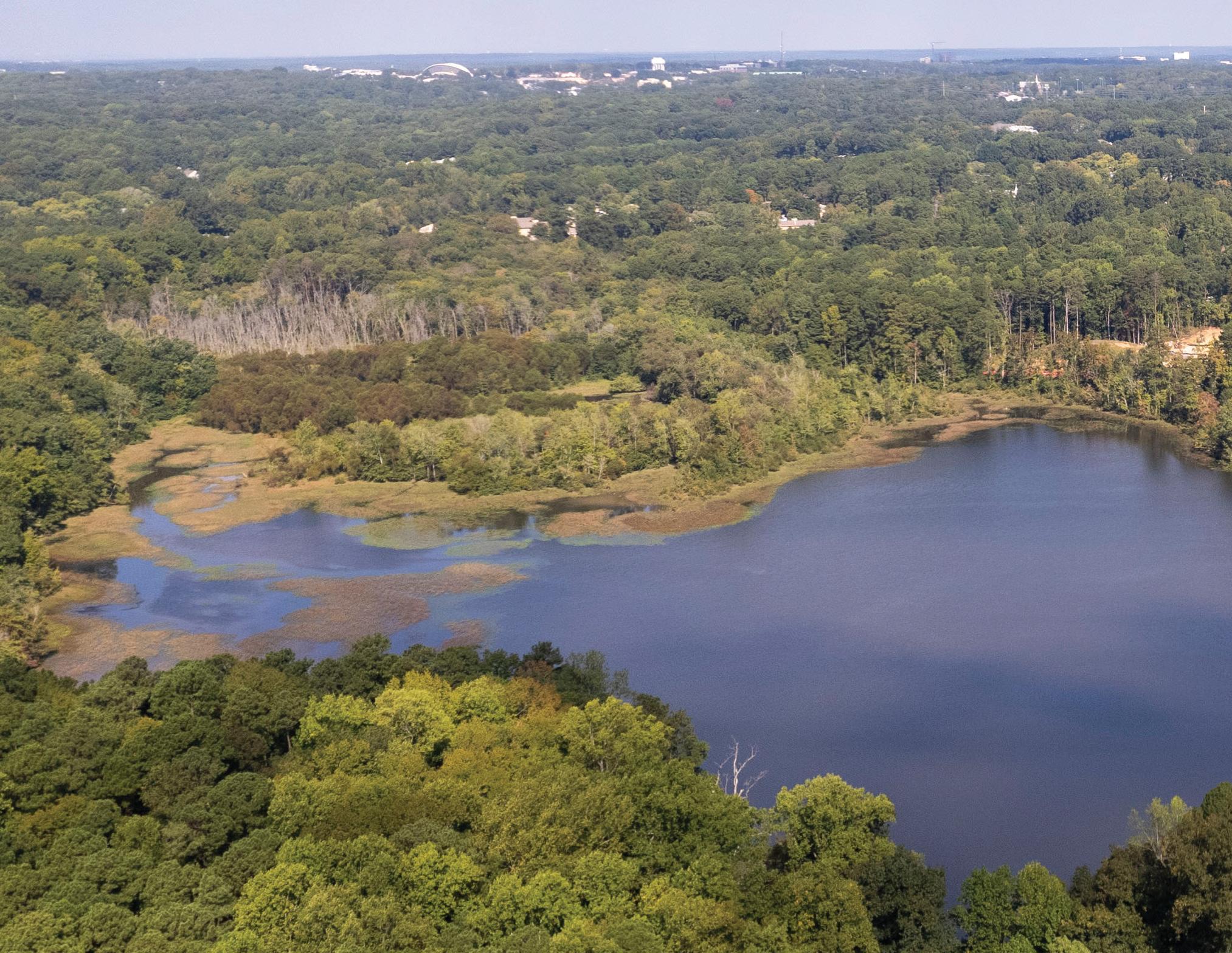
Create a connected lake by improving visual and physical connections between the Lake Raleigh area and Centennial Campus, Main Campus, and the broader Raleigh region.
en VI ron M en Ta L
s T e Wards HIP
Maintain environmental quality at Lake Raleigh to allow for a place of natural beauty and respite.
Create outdoor recreation opportunities and programming to encourage active lifestyles and provide space for respite and relaxation to support mental wellness for all users of Lake Raleigh area.
Utilize the natural environment at Lake Raleigh and Lake Raleigh Woods to provide research and learning opportunities for NC State students and faculty alongside co-learning public research and community learning programs.

ar T s + en T er Ta I n M en T
Grow the arts and entertainment presence and offerings at Lake Raleigh area to create a unique sense of place and elevate the area as a campus focal point for creative exploration and expression.


This chapter serves as the heart of Activate Lake Raleigh and is organized according to five (5) Activation Focus Areas as identified through the planning process. Each focus area is associated with a set of goals, objectives, and initiatives intended to guide the implementation process.
IN THIS CHAPTER
1. Connectivity
2. Environmental Stewardship
3. Health + Wellness
4. Education + Research
5. Arts + Entertainment
A number of variables were considered in the identification and evaluation of the goals, objectives, and initiatives for the Activate Lake Raleigh Plan. Within each Focus Area, an Implementation Framework specific to the section outlines the variables for each strategy. The variables include Campus-Wide Strategic Goals, Activation Benefit, Demographic Groups, Implementation Resources, Ongoing Resources, and Community Interests. A description of the variables used to assess each initiative follows.
ca MP us -WI de s T raT eg I c goa L s
There are seven strategic goals set forth in the NC State Strategic Plan: “Wolfpack 2030: Powering the Extraordinary”. All of the Activate Lake Raleigh strategies are aligned with at least one campus-wide strategic goal. The NC State Strategic Goals are as follows:
goa L 1: Empower students for a lifetime of success and impact.
goa L 2: Ensure preeminence in research, scholarship, innovation, and collaboration.
goa L 3: Expand and advance our service to the citizens of the state and beyond — defining the standard for a 21st-century land-grant university.
goa L 4: Champion a culture of equity, diversity, inclusion, belonging, and well-being in all we do.
goa L 5: Drive institutional effectiveness through transformative technologies, cutting-edge processes, and actionable data.
goa L 6: Be recognized as the leading university for innovative partnerships, entrepreneurial thinking, and applied problemsolving.
goa L 7: Elevate the national and global reputation and visibility of NC State.
Based on community feedback and guidance from the Project Committee, the level of activation benefit or impact was evaluated for each strategy. The Activation Benefit is classified as High, Medium, and Low.
The Project Committee identified four major groups of Lake Raleigh area users. Each strategy was evaluated to determine which group or groups of users would benefit from the implementation of the strategy. The groups include:
• Students: NC State students from Main Campus and Centennial Campus.
• Faculty and Staff: NC State faculty and staff from Main Campus and Centennial Campus.
• Community: Residents of Centennial Campus and the Greater Raleigh Area who utilize the Lake Raleigh area now or in the future.
• Industry Partners: Employees of Centennial Campus private businesses who work on campus part or full time.
With guidance from the Project Committee, the amount of funding required to implement the strategy was estimated. This is not a definitive budget number, but instead a rough estimate of cost. The Implementation Resources are categorized as follows:
• Free/Minimal: Can implement at low or no cost.
• Low: Under $100,000 required to implement.
• Medium: Between $101,000 to $499,000 required to implement.
• High: Over $500,000 required to implement.
Based on guidance from the Project Committee, the amount of resources required to operate and maintain the strategy once implemented was assessed. Resources could be financial, staffing, or other needs. The Ongoing Resources categories are High, Medium, and Low.
Based on community input during the public engagement sessions and guidance from the Project Committee, the amount of Community Interest was evaluated for each strategy. The categories for Community Interest are High, Medium, and Low.
Connectivity refers not only to the creation of direct physical linkages between the Lake Raleigh area and Centennial Campus, but also to increased programming and extending awareness to other areas of campus and the broader Raleigh community. By improving both the tangible and intangible bonds between Lake Raleigh and the surrounding community, Activate Lake Raleigh will allow the area to become a more attractive destination.
The Connectivity Focus Area includes two main goals, six objectives, and 16 specific implementation initiatives designed to functionally incorporate the Lake Raleigh area with its campus surroundings and the greater community.
goa L 1: creaT e a connec T ed L ake
By improving connectivity to Centennial Campus, Main Campus, and the broader Raleigh community, there is great potential for the creation of a connected lake. The objectives listed below suggest connectivity improvements, including updates to the existing multimodal transportation system, investments in capital infrastructure, and additional programming tailored to particular user groups.
o BJ ec TIV e 1.1: re I n F orce connec TI ons T o cen T enn I a L ca MP us
Although it is directly adjacent and connected to Centennial Campus, the Lake Raleigh area tends to be unnoticed and underutilized by the campus and greater Raleigh communities. The initiatives below aim to reinforce community connections to Centennial Campus and Lake Raleigh area by strengthening existing connections and creating new ones where appropriate.
1.1.1 Maintain Sight Lines and Visual Connections. Establish visual connection from The Oval to Lake Raleigh through selective tree removal or pruning. Having unobstructed views of the lake from Hunt Library and maintaining open space at the South Oval Hub* will help reinforce this connection.
1.1.2 Add Pathway Connections to South Oval Hub*. Strengthen connection to Centennial campus via additional neighborhood paths. Significant enhancements to the existing pedestrian network will be required.
1.1.3 Complete the Lake Raleigh Loop Trail. Complete the trail around the lake, including boardwalk and observation decks. The Lake Raleigh Loop Trail Study demonstrates the feasibility and potential location of specific infrastructure improvements required for the project.
*For more information, refer to the NC State Physical Master Plan.
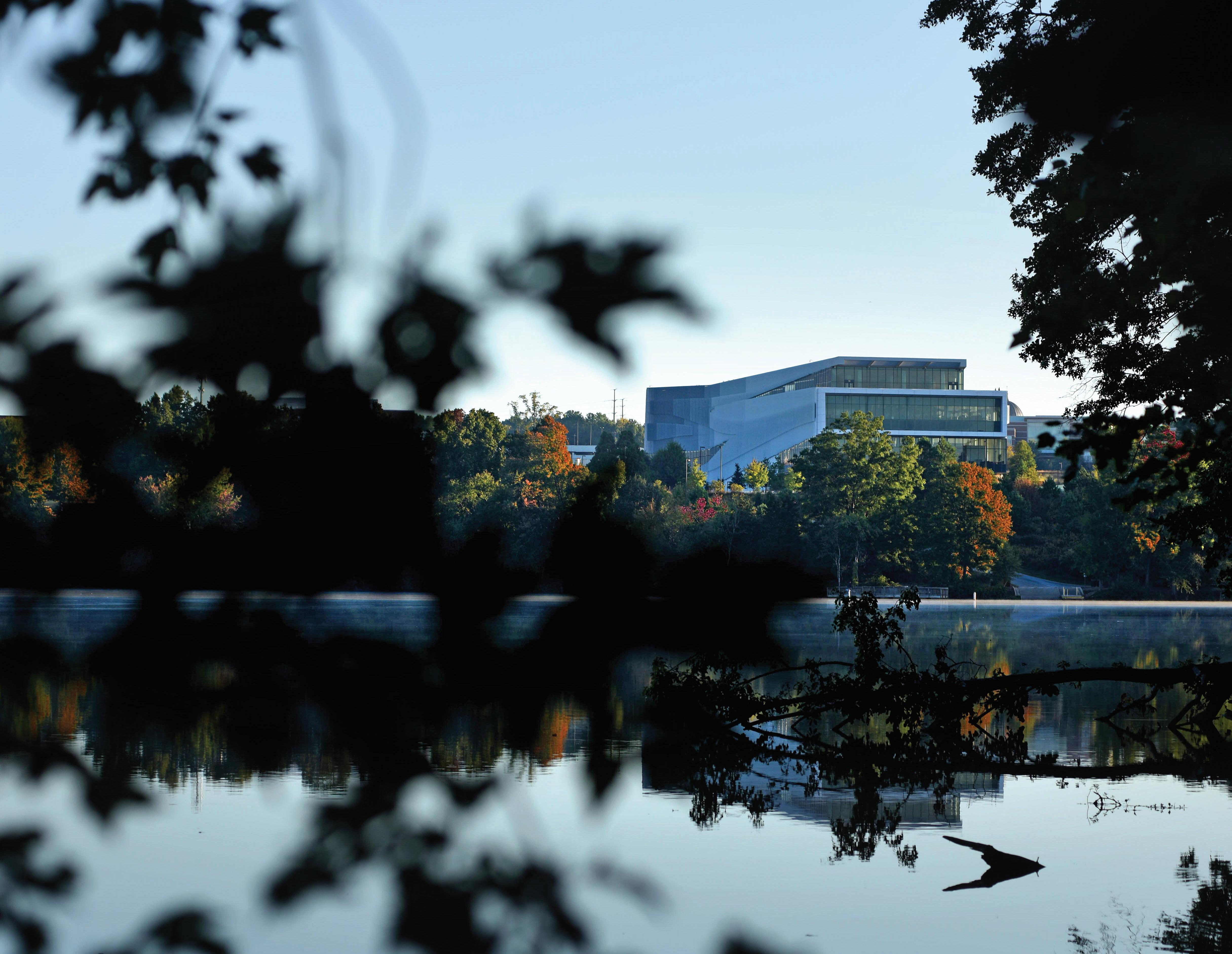
A connected Lake Raleigh includes maintaining unobstructed views from Hunt Library and other Centennial Campus locations to help raise awareness of this revered area.
o BJ ec TIV e 1.2: e XT end connec TI ons T o TH e ca MP us core
Both vehicular and non-vehicular transportation systems are utilized on NC State campus. The following initiatives provide modifications and improvements to these transportation systems that will offer significant mobility and connectivity benefits which can extend to further reaches of campus.
1.2.1 Extend the Pathway System. Establish physical connections to Lake Raleigh through multimodal campus pathways, including proposed All Campus Paths and Neighborhood and Connector Paths.
1.2.2 Increase Public Transit. Consider adding Lake Raleigh to the Wolfline system once programmatic opportunities at Lake Raleigh increase. As conditions change and demand grows, route modifications and additional services should be studied, including on-demand shuttles.
1.2.3 Upgrade the Micromobility Transportation Network. Transform Main Campus Drive to better accommodate nonmotorized traffic using sharrows, bike lanes, and side paths where appropriate.
o BJ ec TIV e 1.3: s T reng TH en connec TI ons T o co MM un ITY
( ra L e I g H/ genera L P u BLI c )
Residents and corporate tenants, as well as members of the general public, comprise a significant and key portion of the Centennial Campus and Lake Raleigh community. The intentional involvement of these groups in activation efforts will help foster a strong sense of community.
1.3.1 Offer More Programs for the General Public. Establish additional community connections through programming designed to attract new users; e.g. personal enrichment classes. This type of programming will meet a growing demand by the community and help build and garner support from a variety of community interests.
1.3.2 Develop More Public Destinations. Establish community connections through development of new assets/opportunities
that appeal to the general public, e.g. event stage. These new assets should be designed to complement the area’s character and add to its sense of place.
1.3.3 Establish Connections to Adjacent Areas. Connect to the City of Raleigh + Dix Park via greenway links and trails. Extending and enhancing connections to these adjacent areas will encourage more interaction with the abundant opportunities found in this urban park landscape.
1.3.4 Engage Centennial Campus Industry Partners and Residents.
Strengthen connections to industry partners and residents through programming and outreach efforts targeted specifically to these groups. This group is an integral part of the community and it will be vital to identify and address any specific needs.
o BJ ec TIV e 1.4: IMP ro V e and e XPand W aYFI nd I ng F or L ake ra L e I g H
A simple and effective technique for attracting and directing more people to amenities at Lake Raleigh is to include the area within the NC State wayfinding system.
1.4.1 Include Lake Raleigh on Existing Wayfinding Signage. Add Lake Raleigh area and Lake Raleigh Woods as a destination on existing campus wayfinding signs. The University has an existing vehicular wayfinding system that should be used to increase awareness.
1.4.2 Install Wayfinding Signage for Lake Raleigh Destinations. Add vehicular and pedestrian wayfinding signage for Lake Raleigh area and Lake Raleigh Woods in close proximity to Centennial Campus, Magnet Middle School, the Point, Park Alumni Center, and StateView Hotel.
goa L 2: de FI ne TH e s Pace
One of the most desired outcomes of the planning process is for the Lake Raleigh area to become more widely known for its inherent value and significance as an outstanding community asset. The following initiatives aim to robustly promote this extraordinary resource and its numerous possibilities.
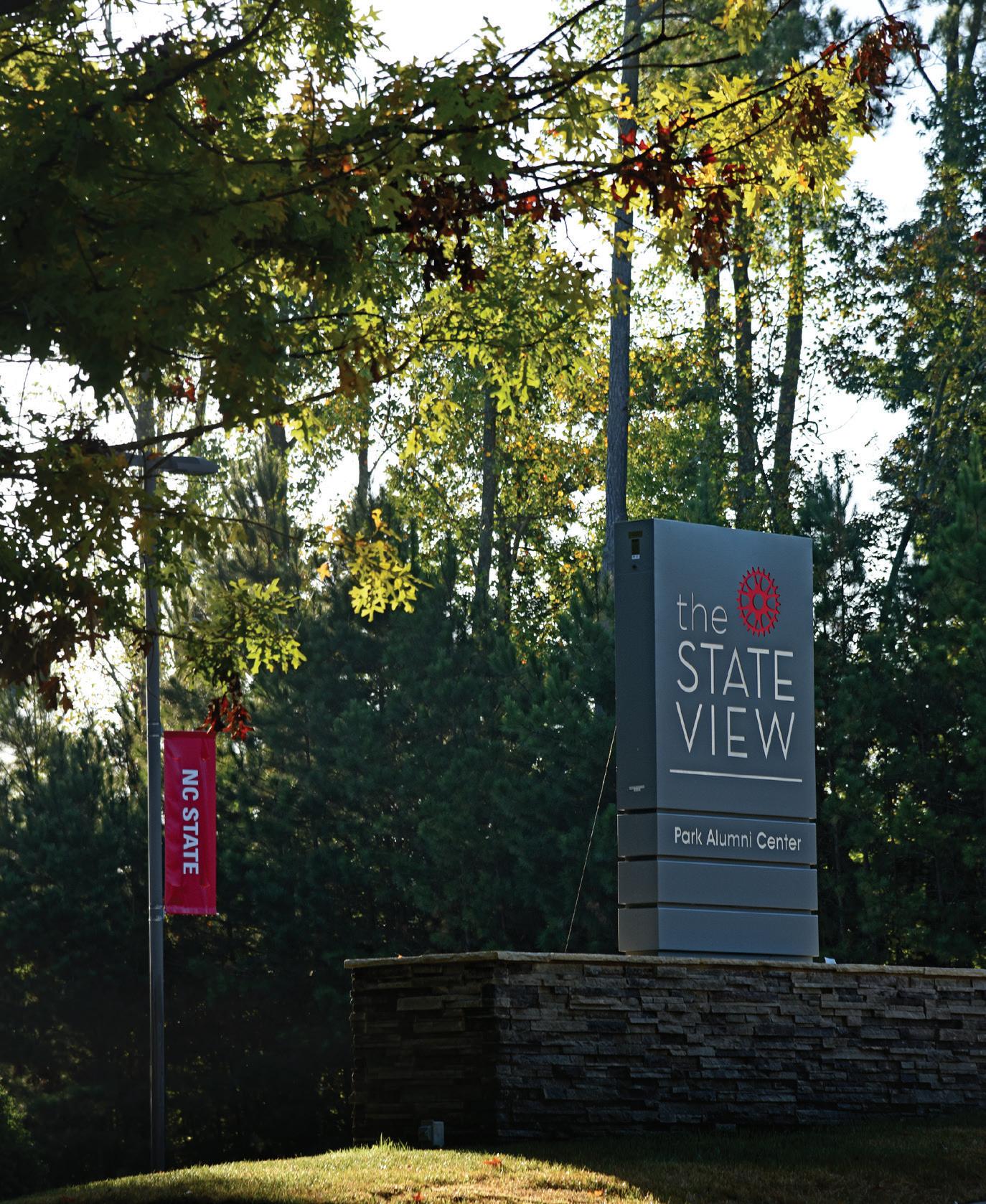
o BJ ec TIV e 2.1: L ake ra L e I g H area I den TITY
The overall identity strategy for the Lake Raleigh area should begin with consistent usage and reference to its standard moniker and visual representation. An unmistakable and memorable identity is needed to help position and further establish the Lake Raleigh area as a dynamic and attractive destination.
2.1.1 Create a New Identity for the Lake Raleigh area. Consider opportunities for new name and visual identity of the Lake Raleigh area that take into account the stakeholder audiences and envisioned programs. The identity should demonstrate the area’s distinct character and essence.
2.1.2 Develop New Promotional Material. Develop promotional materials that include the new name and visual identity for Lake Raleigh area. These materials will be used to help generate interest about the area and distinguish it as an authentic place to experience.
o BJ ec TIV e 2.2: P ro M oT e L ake ra L e I g H area
A promotion campaign featuring compelling content and regular posting is an inexpensive and powerful solution to effectively engage with potential visitors and encourage involvement and participation for a wide variety of community members. The initiatives below suggest effective promotional strategies.
2.2.1 Create a Social Media Presence. Initiate a coordinated social media campaign. Use social media outlets and channels to post short-form videos, images, and stories promoting programs and events.
2.2.2 Engage the Community through E-Newsletter and Email Campaigns. Update e-newsletter and email campaigns for maximum engagement. Continue to build and add subscribers and regularly distribute compelling emails and newsletters that keep the community updated.
1.1.1 Establish visual connection from The Oval to Lake Raleigh through selective tree removal or pruning.
1.1.2 Strengthen connection to Centennial Campus via additional neighborhood paths.*
1.1.3 Complete the trail around the lake including boardwalk and observation decks.
1.2.1 Establish physical connections to Lake Raleigh through multimodal campus pathways, including proposed All Campus Paths and Neighborhood and Connector Paths.*
1.2.2 Consider adding Lake Raleigh to the Wolfline system once programmatic opportunities at Lake Raleigh increase.
1.2.3. Transform Main Campus Drive to better accommodate non-motorized traffic using sharrows, bike lanes, and side paths where appropriate.*
1.3.1 Establish additional community connections through programming designed to attract new users, e.g. personal enrichment classes.
1.3.2 Establish community connections through development of new assets/ opportunities that appeal to the general public, e.g. event stage.
1.3.3 Connect to City of Raleigh + Dix Park via greenway links and trails.*
1.3.4 Strengthen connections to industry partners and residents through programming and outreach efforts targeted specifically to these groups.
1.4 IMPROVE AND EXPAND WAYFINDING FOR LAKE RALEIGH
1.4.1 Add Lake Raleigh area and Lake Raleigh Woods as a destination on existing campus wayfinding.
1.4.2 Add vehicular and pedestrian wayfinding signage for Lake Raleigh area and Lake Raleigh Woods in close proximity to Centennial Campus Magnet Middle School, the Point, Park Alumni Center, and StateView Hotel.
2.1.1 Consider opportunities for new name and visual identity of the Lake Raleigh area that take into account the stakeholder audiences and envisioned programs.
2.1.2 Develop promotional materials that include the new name and visual identity for Lake Raleigh area.
2.2.1 Initiate a coordinated social media campaign.
2.2.2 Update e-newsletter and email campaign for maximum engagement.
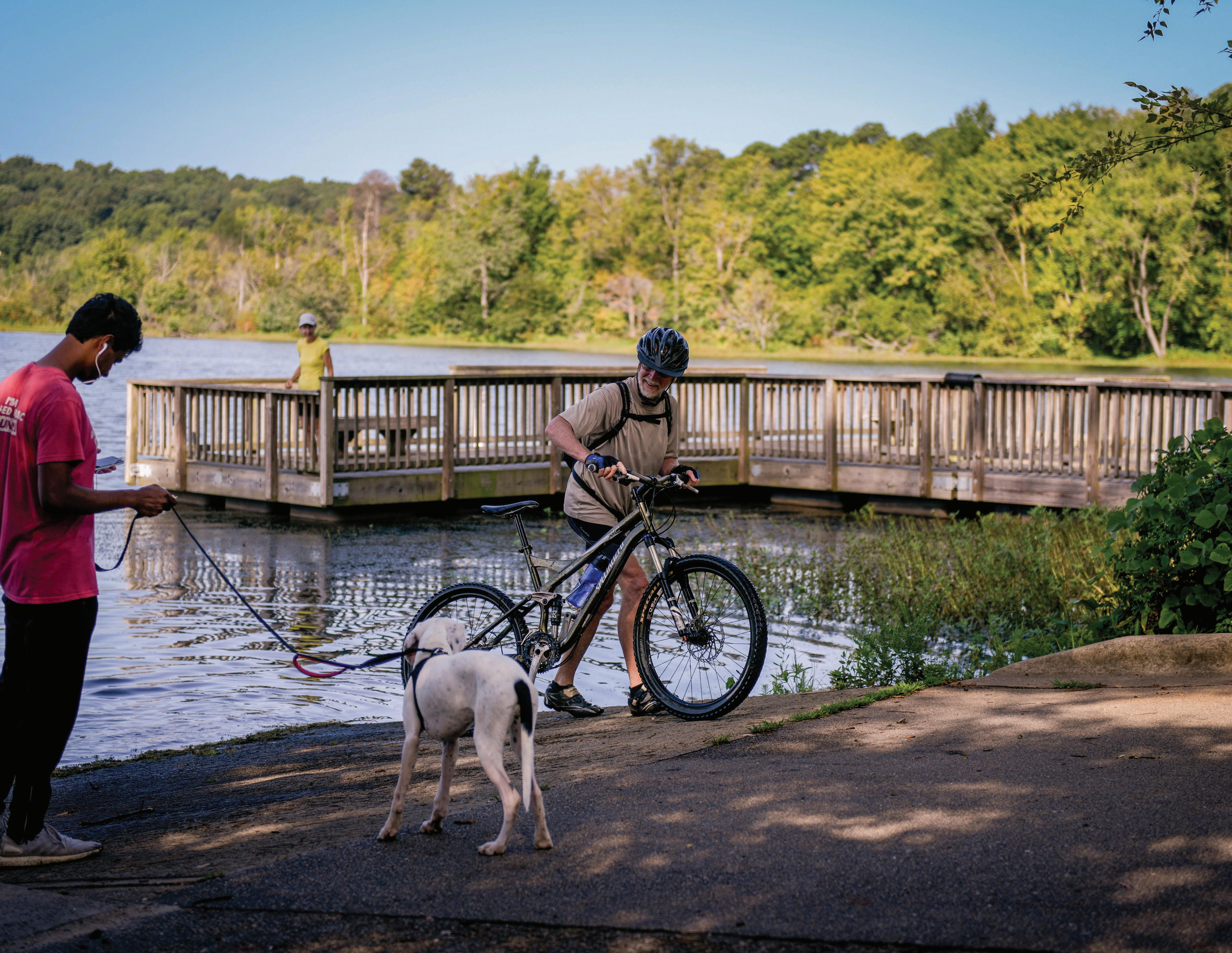
The environment and setting at Lake Raleigh provides a unique enclave of nature that merits special considerations. The environment should be maintained through organizational practices that use resources responsibly and cause no pervasive harm. Proper environmental stewardship will help safeguard the landscape and natural beauty.
The Environmental Stewardship focus area includes three main goals, five objectives, and 11 specific implementation initiatives intended to help protect and improve the ecosystem of the Lake Raleigh area and to position the University as an exceptional steward of the natural resources found there.
goa L 1: res T ore en VI ron M en Ta L Q ua LITY
aT L ake ra L e I g H
Off-campus development and land use change within the Walnut Creek watershed over the past several decades have contributed to increased stormwater runoff and sedimentation loads. These conditions have led to the degradation of water quality, loss of habitat, and the proliferation of invasive species in the Lake Raleigh area. Environmental conditions in the watershed justify significant attention to land and water resources. The following initiatives support habitat restoration and remediation efforts.
o BJ ec TIV e 1.1: su PP or T and Par TI c IPaT e I n researc H and ongo I ng e FF or T s T o address TH e en VI ron M en Ta L Q ua LITY o F TH e area
Rigorous efforts are necessary to remedy the environmental issues facing Lake Raleigh. Erosion, sedimentation, and impairment issues may be confronted through both voluntary and formal maintenance programs. Supporting and participating in these kinds of programs can be an advantageous and effective strategy for addressing environmental concerns.
1.1.1 Support Volunteerism. Establish volunteer groups to “adopt” and maintain the lake, trails, and related amenities. Volunteerism is an effective way to maintain the area, provide participants with recognition, and produce rewarding teambuilding experiences.
1.1.2 Investigate the Benefits of Watershed Planning. Explore programs focused on watershed restoration (e.g., Urban Water Federal Partnership program) and evaluate whether engagement in such a program is beneficial to the Lake Raleigh area. Programs are typically driven by community stakeholders and often identify problems and potential solutions that can improve watershed conditions.
o BJ ec TIV e 1.2: address curren T concerns regard I ng
TH e W aT er Q ua LITY o F L ake ra L e I g H
There are several readily identifiable strategies that could substantially improve the water quality situation at Lake Raleigh. Though not simple, the methods below are justifiable and may be necessary to address impaired surface waters.
1.2.1 Control the Spread of Aquatic Weeds. Eradicate invasive aquatic vegetation species to the maximum extent practical. Hydrilla is an invasive species causing major concern for the aquatic ecosystem at Lake Raleigh. Removal is difficult and eradication may involve several techniques, including water drawdown, physical removal, and chemical control.
1.2.2 Dredge the Lake. Explore the viability of dredging the lake, and understand the ecological benefits it will have on the Lake Raleigh area. Dredging will remove sediment and other materials from the lake to help with habitat restoration. There are two main dredging methods, mechanical and hydraulic, each of which are intensive processes requiring state and federal permits.
1.2.3 Remove Aquatic Trash. Assess conditions and remove floatable debris and trash from the lake and along the lakeshore regularly. Aquatic trash affects water quality, endangers plant and animal habitat, and detracts from the aesthetic and recreation value of the area.
Invasive vegetative species threaten the balance of the ecosystem at Lake Raleigh and detract from its recreational value. Unchecked, infestations of exotic species will continue to grow and spread quickly throughout the surface waters here.

goa L 2: M a I n Ta I n en VI ron M en Ta L Q ua LITY aT L ake ra L e I g H and L ake ra L e I g H W oods
The environmental quality should be maintained at a level equal to, or better than, current conditions. Deliberate measures must be taken to protect the existing land and water resources. Unfavorable environmental factors such as noise, litter, and glaring visual impacts should be negligible, as each of these contribute to how the area is experienced and perceived. The initiatives in this section suggest protection and preservation strategies.
o BJ ec TIV e 2.1 P reser V e TH e I rre PL acea BL e c H arac T er o F TH e naT ura L L andsca P e and eco L og Y o F TH e area
The Lake Raleigh area is a rare and special place within Centennial Campus and the City of Raleigh. The natural setting occupied by this community asset is uncommon for an urban campus and therefore commands resolute stewardship and preservation.
2.1.1 Manage the Woods. Implement a forest management plan for the existing resource in accordance with the Lake Raleigh Woods General Management Plan. Under direction of the Lake Raleigh Woods Advisory Committee, continue the ongoing efforts to manage this valuable asset.
2.1.2 Protect the Ecology through Interdisciplinary Conservation Efforts. Consider partnering with the Fisheries, Wildlife and Conservation Biology program, Department of Forestry and Natural Resources, and Department of Applied Ecology to develop ideas for potential innovative conservation and habitat protection strategies.
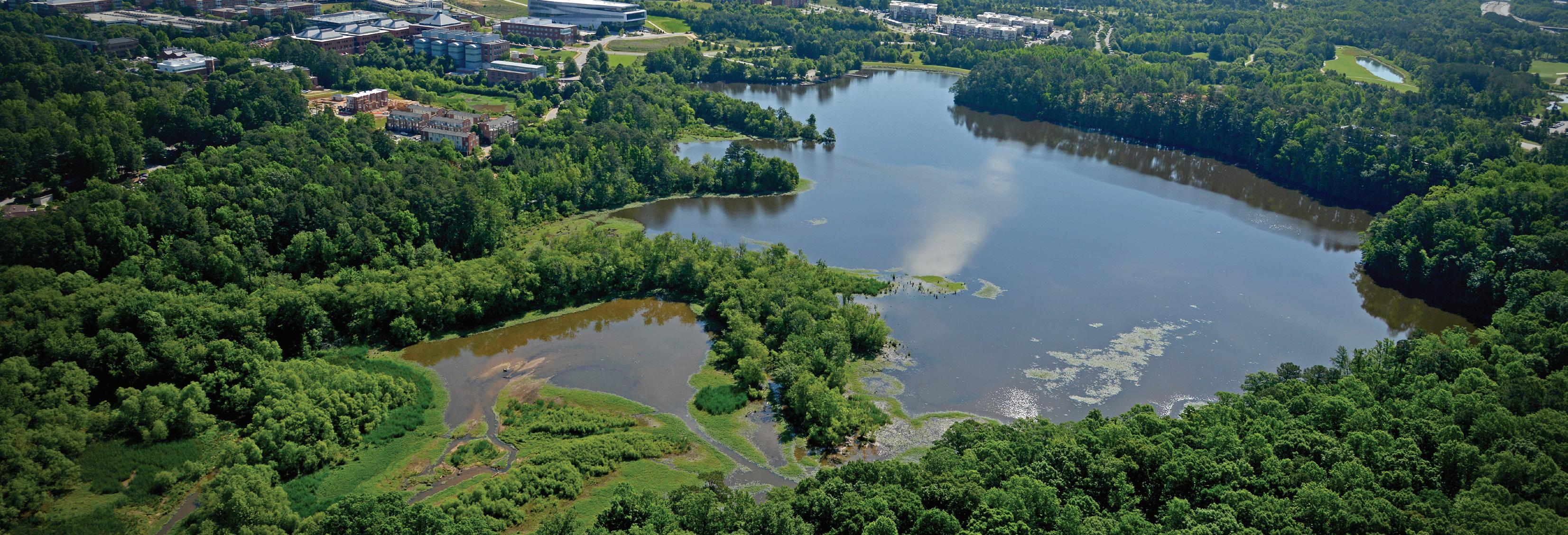
o BJ ec TIV e 2.2 P roT ec T TH e W aT er Q ua LITY o F L ake
ra L e I g H us I ng MITI gaTI on M easures TH aT MI n IMIZ e IMPac T s F ro M non -P o I n T source P o LL u TI on
Non-point source pollution is a leading cause of the water quality issues in the Walnut Creek watershed. This pollution comes primarily from stormwater runoff and contains harmful pollutants, such as sediment, bacteria, nutrients, and toxic chemicals. To minimize runoff, innovative stormwater control measures should be implemented for all new development and redevelopment projects in the area.
2.2.1 Install Innovative Stormwater Control Measures. Identify locations to explore potential implementation of best management practices (BMP) demonstration areas in partnership with the Department of Civil, Construction, and Environmental Engineering.
2.2.2 Reduce Runoff + Impervious Surfaces. Limit stormwater runoff by carefully considering impervious surfaces related to all improvements conducted in the Lake Raleigh area. Impervious surfaces primarily result from roads, parking lots, and rooftops associated with new construction projects.

goa L 3: P reser V e e XI s TI ng o P en s Pace
Public engagement shows a strong preference that the Lake Raleigh area remain mostly undeveloped and not become overwhelmed by the built environment. This immense, publicly accessible open space adds tremendous value to the community and should be protected from large-scale development and urbanization pressures.
o BJ ec TIV e 3.1 recogn IZ e and ca PITa LIZ e on TH e V a L ue
o F e XI s TI ng o P en s Pace asse T s
Future development plans in the Lake Raleigh area will require careful consideration and regard for the existing landscape.
Raising awareness about the opportunities at Lake Raleigh and the ecological benefits of this valuable open space will help maintain its integrity.
3.1.1 Thoughtful Development. Sustain the recreational, environmental, social, and educational benefits of the Lake Raleigh area by carefully considering impacts of any development adjacent to the lake, with additional scrutiny of activity affecting Lake Raleigh Woods.
3.1.2 Celebrate the Distinction of the LRW Hallowed Place. Promote and raise awareness of the Lake Raleigh Woods Hallowed Place concept to garner campus and civic pride. The University has awarded Lake Raleigh Woods this distinct recognition due to the unparalleled natural setting on campus and the significance of this warrants celebration.
1.1.1 Establish volunteer groups to “adopt” and maintain trails, lake, and related amenities.
1.1.2 Explore programs focused on watershed restoration (e.g., Urban Water Federal Partnership program) and evaluate whether engagement in such a program is beneficial to the Lake Raleigh area.
1.2.1 Eradicate invasive aquatic vegetation species to the maximum extent practical.
1.2.2 Explore the viability of dredging the lake, and understand the ecological benefits it will have on the Lake Raleigh area.
1.2.3 Assess conditions and remove floatable debris and trash from the lake and along the lakeshore regularly.
2.1.1 Implement forest management plan for the existing resource in accordance with the Lake Raleigh Woods General Management Plan.
2.1.2 Consider partnering with the Fisheries, Wildlife and Conservation Biology program, Department of Forestry and Natural Resources, and Department of Applied Ecology to develop ideas for potential innovative conservation and habitat protection strategies.
2.2.1 Identify locations to explore potential implementation of best management practices (BMP) demonstration areas in partnership with the Department of Civil, Construction, and Environmental Engineering.
2.2.2 Limit stormwater runoff by carefully considering impervious surfaces related to all improvements conducted in the Lake Raleigh area.
3.1.1 Sustain the recreational, environmental, social, and educational benefits of the Lake Raleigh area by carefully considering impacts of any development adjacent to the lake, with additional scrutiny of activity affecting Lake Raleigh Woods.
3.1.2 Promote and raise awareness of the Lake Raleigh Woods Hallowed Place concept to garner campus and civic pride.
Lake Raleigh area currently offers outdoor recreation opportunities to both NC State students, faculty, and staff and the broader community. The 75-acre Lake Raleigh is suitable for non-motorized boating and fishing. Hiking, walking, jogging, and biking can be enjoyed on the Walnut Creek Greenway and natural surface trails in Lake Raleigh Woods. In addition to outdoor recreation, an important goal for Activate Lake Raleigh is to provide a natural space that provides respite and relaxation to support mental wellness for everyone.
The Health + Wellness Focus Area includes three main goals, three objectives, and 11 specific implementation initiatives that focus on improving or expanding existing natural and built assets and making the health and wellness opportunities available to a larger number of users.
goa L 1: encourage ac TIV e LIF es TYL es
With its location on NC State’s campus and the close proximity to downtown Raleigh, Lake Raleigh area is a convenient urban oasis for outdoor recreation. It currently provides opportunities for NC State students, faculty, staff, and local residents to participate in outdoor activities and exercise easily reached from where they live, work, and learn. The objectives listed below build on the current success of the area with the aim to make opportunities more accessible and increase participation by various user groups.
o BJ ec TIV e 1.1: P ro VI de des TI naTI on Q ua LITY ou T door recreaTI on o PP or T un ITI es
Lake Raleigh area currently has a variety of opportunities for outdoor recreation, but many NC State students, faculty, and staff and local community members either do not know about them or would like a more enhanced experience. The initiatives below aim to improve, expand, and add to the existing outdoor recreation infrastructure.
1.1.1 Enhance and improve disc golf course. The disc golf course is currently 9-holes. Consider upgrading the existing course or moving it to a new location and expanding it to 18-holes to make it more inviting and accessible to the community.
Disc golf is a popular pastime for students and community members. Many disc golf players in the community completed the Activate Lake Raleigh survey and expressed a desire to improve and expand the disc golf course.
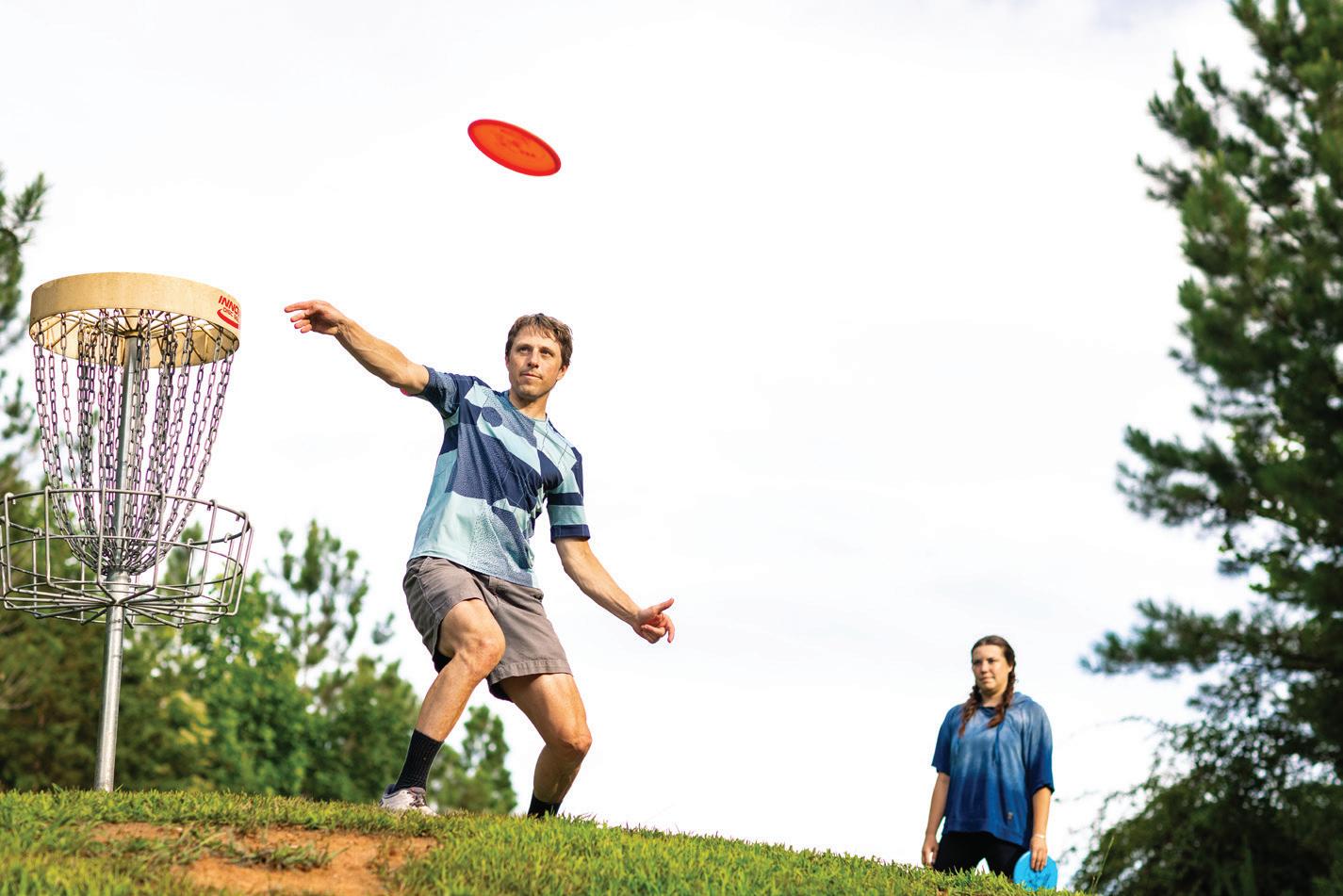
1.1.2 Enhance and improve natural surface trails. Lake Raleigh Woods currently has just over four miles of natural surface trails. Completing the trail around the lake and expanding the current natural surface trail system will make the trails more accessible for all users.
1.1.3 Expand programming to encourage non-motorized watersports at Lake Raleigh. Some members of the community currently kayak, canoe, and paddle board on the lake. Although Lake Raleigh is small, it is a unique and convenient destination for paddling. Explore making it a more attractive destination for non-motorized boating by increasing the number of lake access points and creating destination points around the lake. Additionally, adding amenities for kayaking and paddling such as lockers for storing boats, instruction, and beginner classes, will help make paddling at Lake Raleigh more accessible to a broader community of users.
1.1.4 Install treeweaves to allow access to the tree canopy. Treeweaves are custom and colorful nets that are handwoven into the tree canopy to provide a tree-playground for children and adults. Explore contracting with Treeweaves or a similar company to install a unique tree canopy playground in Lake Raleigh Woods.
1.1.5 Offer equipment and gear rentals. Although some gear rentals are available through the NC State Outdoor Adventures program, it can be difficult for students to transport larger gear like kayaks and paddleboards to the lake. Many students and community members expressed interest in renting equipment on or near the lake. Explore opportunities to partner with Outdoor Adventures, the NC State sailing club, and local entrepreneurs to provide a variety of gear rental, such as kayaks, canoes, paddle boards, sailboats, and mountain bikes.
Treeweaves mimics the height, stability, safety, and support of a treehouse and allow occupants to experience all the sensations of being outside while enjoying a unique vantage point within the tree canopy. photo from treeweaves.com

goa L 2: con T r IB u T e T o M en Ta L W e LL ness
Supporting mental well-being for students, faculty, and staff is a high priority for NC State leaders. Research shows that having access to a natural environment, such as the lake and the woods, can be beneficial for mental and physical health (Kondo et al., 2018 and Cox et al., 2017). Creating spaces that maintain the natural environment and support unstructured time in nature is an important goal for the Lake Raleigh area.
o BJ ec TIV e 2.1 P ro VI de s Pace F or res PIT e and re L a X aTI on The following initiatives aim to support mental well-being by creating dedicated spaces and opportunities to experience quiet and solitude in nature throughout the Lake Raleigh area.
2.1.1 Establish a sensory or tranquility garden. A sensory garden is designed to stimulate all five senses and provide a calming and therapeutic environment for everyone. The garden can help reduce stress and anxiety as well as improve cognitive function and memory.
By stimulating and supporting all five senses, a sensory garden provides a space for relaxation in a natural environment. They are especially well-suited to provide a place of respite for people with disabilities. photo from homesandgardens.com

Kondo MC, Fluehr JM, McKeon T, Branas CC. Urban Green Space and Its Impact on Human Health. Int J Environ Res Public Health. 2018 Mar 3;15(3):445. doi: 10.3390/ijerph15030445. PMID: 29510520; PMCID: PMC5876990.
Cox DT, Shanahan DF, Hudson HL, Fuller RA, Anderson K, Hancock S, Gaston KJ. Doses of Nearby Nature Simultaneously Associated with Multiple Health Benefits. Int J Environ Res Public Health. 2017 Feb 9;14(2):172. doi: 10.3390/ijerph14020172. PMID: 28208789; PMCID: PMC5334726.
2.1.2 Install new outdoor furnishings. Installing a variety of seating and benches on the shore of Lake Raleigh, in Lake Raleigh Woods, and along the greenway will allow people to sit and enjoy lake views or quiet time in nature. Many NC State faculty and staff and Centennial Campus industry partners expressed a desire to escape the office and eat lunch or take a break near the lake during the workday.
2.1.3 Create a hammock grove. Hammocks are especially popular with students, but finding suitable places on campus can be challenging. Consider installing a permanent hammock grove to provide students and the community with a place to enjoy relaxing in a hammock without having to own or hang a hammock.
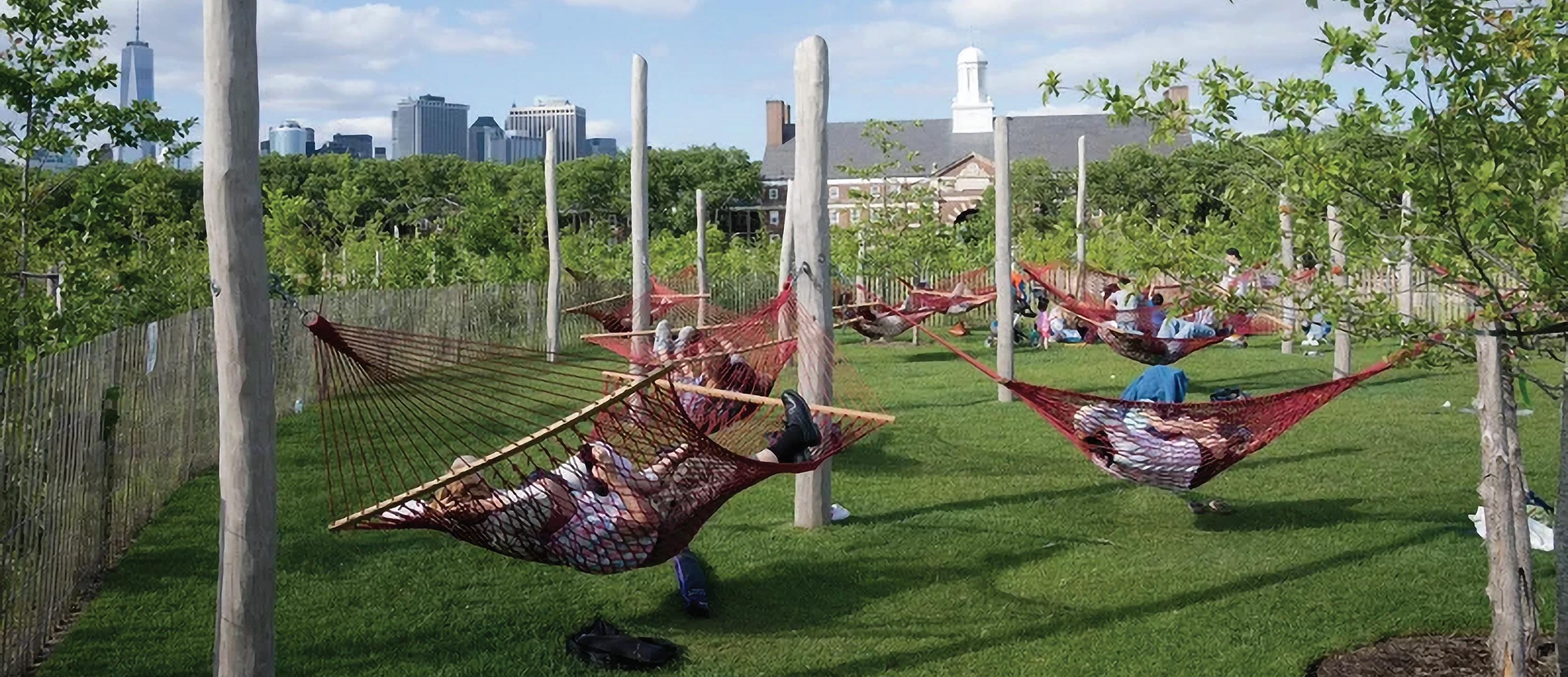
A hammock grove, like this one at Governors Island in New York, provides a unique respite and opportunity to relax or nap in nature. photo from outsideonline.com (Timothy Schenck)
goa L 3: P os ITI on L ake ra L e I g H as a P r IM ar Y recreaTI on H u B
Lake Raleigh area currently provides several recreation opportunities for the NC State community, but many students, faculty, and staff have never visited or do not know how to access Lake Raleigh or Lake Raleigh Woods. The goal of the initiatives in this section is to further activate Lake Raleigh as a recreation hub on campus and in the community.
o BJ ec TIV e 3.1 d I scuss WITH s Take H o L ders TH e
o PP or T un ITY T o o PTIMIZ e TH e L ake ra L e I g H area as a des TI naTI on F or recreaTI on
Convene the key stakeholders who are interested in expanding the offerings at Lake Raleigh area and elevating its visibility and importance on campus. If necessary, identify funding sources to help implement the Health + Wellness recommendations in this section.
3.1.1 Consider partnering with relevant departments to identify programs and activities. Work with relevant departments, such as Wellness and Recreation, Parks and Recreation, University College, and Tourism to identify programs and activities to enliven the area for NC State students, faculty, and staff.
3.1.2 Incorporate the Recreation Area into core offerings. Once potential programs and activities are identified, work with the relevant university departments to make the opportunities a core component of the department teaching and offerings.
3.1.3 Consider partnering with local community and student groups for events that involve the natural surface trails and lake. Work with relevant NC State partners, such as student and community groups, to host and expand events and activities that involve the natural surface trails and the lake, such as 5K runs, paddling events, outdoor fitness classes, etc.
Events like the Polar Plunge allows students and community members to enjoy the lake and participate in outdoor activities.

ENCOURAGE ACTIVE LIFESTYLES HW2: CONTRIBUTE TO MENTAL WELLNESS
1.1 PROVIDE DESTINATION QUALITY OUTDOOR RECREATION OPPORTUNITIES
1.1.1 Enhance and improve disc golf course.
1.1.2 Enhance and improve the natural surface trails.
1.1.3 Expand programming to encourage non-motorized watersports at Lake Raleigh.
1.1.4 Install tree weaves to allow access to the tree canopy.
1.1.5 Offer equipment and gear rentals for paddling, biking, fishing, sailing.
2.1 PROVIDE SPACE FOR RESPITE AND RELAXATION
2.1.1. Establish a sensory/tranquility garden.
2.1.2 Install new outdoor furnishings (seats, benches, etc).
2.1.3 Create a hammock grove.
HW3: POSITION LAKE RALEIGH AS A PRIMARY RECREATION HUB
3.1 DISCUSS WITH STAKEHOLDERS THE OPPORTUNITY TO OPTIMIZE THE LAKE RALEIGH AREA AS A DESTINATION FOR RECREATION
3.1.1 Consider partnering with the Wellness and Recreation Department or Parks, Recreation, and Tourism to identify programs and activities to enliven the area.
3.1.2 Incorporate recreation area into core wellness and recreational departmental offerings.
3.1.3 Consider partnering with local community and student groups for events that involve the natural surface trails and lake.
The Lake Raleigh area provides educational and learning opportunities in an exceptional environment not often found on major university campuses. For decades, the area has served as an opportune ecological preserve and field laboratory for University faculty and students. Using the space for more formalized research endeavors aligns with the University’s mission of both scholarship and resource stewardship through innovation and collaboration. The space is ideal for creating an inclusive learning environment available for community learning programs.
The Education + Research Focus Area includes three main goals, five associated objectives, and 12 specific initiatives that recommend the existing setting and natural habitats found at Lake Raleigh be used to support additional education and research opportunities, including Citizen Science and public learning programs.
goa L 1: P ro VI de researc H o PP or T un ITI es I n accordance WITH TH e un IV ers ITY’ s r 1 des I gnaTI on Due to the tremendous financial resources allocated for research and the large number of doctorate degrees awarded annually, NC State University is classified as an R1 Research Institution, and the future South Oval Hub on Centennial Campus has been identified as an important center of development in support of the growing academic and research needs of the University. The nearby Lake Raleigh area has tremendous potential to become a space that will accommodate and support all levels of research in numerous departments, and serve as a field laboratory for innovative experiential education.
o BJ ec TIV e 1.1: W ork WITH re L e V an T un IV ers ITY de Par TM en T s T o de V e L o P researc H o PP or T un ITI es
Collaboration with relevant University Centers, Institutes, Departments, and other partners will be required to help identify and establish areas suitable for ongoing research activities.
1.1.1 Identify potential space for advanced research activities.
Explore possible areas of Lake Raleigh and Lake Raleigh Woods that would be beneficial for graduate research projects. These areas could be separate from other research spaces and dedicated to progressive and sophisticated research endeavors.
1.1.2 Identify the potential to support the mission of advanced research. Create an open dialogue with the Office of Research and Innovation to identify how Lake Raleigh and the surrounding area could help meet University research needs and priorities.
o BJ ec TIV e 1.2 de V e L o P s TaT e o F TH e ar T ou T door
L a B oraT or I es and researc H Fac ILITI es
Advanced research activities call for specialized techniques, equipment, and facilities. To guarantee success, identifying the specific requirements for an outdoor laboratory and setting to accommodate this type of research will require extensive cooperation and collaboration by faculty, staff, and scholars. The following initiatives provide insight for a successful outdoor laboratory.
1.2.1 Support the deployment of research apparatus. Explore opportunities with colleges and departments that would benefit from installing and utilizing scientific equipment and monitoring instruments in the Lake Raleigh area.
1.2.2 Encourage projects that are collaborative. Develop a collaborative space for research and related academic endeavors; e.g. a multi-story treehouse for birdwatching. This space is intended to be specifically dedicated to collaborative research projects at the graduate and postgraduate levels.
1.2.3 Establish a field laboratory for advanced research. Open dialogue with relevant University colleges and departments to determine what is required to create a living laboratory in the Lake Raleigh area. User needs and the type of rigorous research conducted in this type of field laboratory will dictate future requirements of this type facility.
With an emphasis on hands-on learning and field studies, Berry College, a small liberal arts college located on 27,000 acres in northwest Georgia, has developed into a leading program for environmental studies. Its outdoor classroom and research laboratory provide an immersive setting for undergraduate research and scientific learning opportunities.
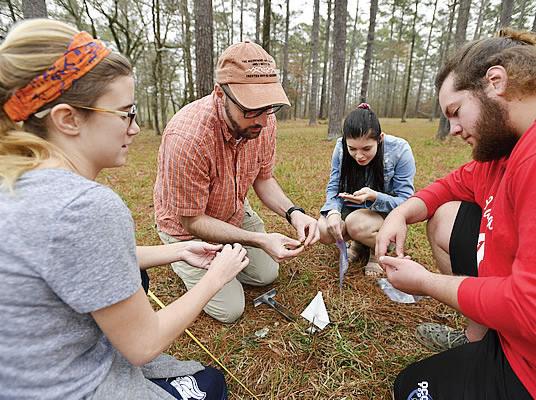
goa L 2: P ro VI de researc H and L earn I ng o PP or T un ITI es F or undergraduaT e curr I cu L a
Establishing a new facility at Lake Raleigh will allow more University departments and undergraduate students to use this enhanced space and learning resource as part of their curriculum. Students in forestry, botany, horticulture, zoology, environmental science, natural resources, parks, recreation, tourism, and other programs will benefit greatly from the learning opportunities the setting offers.
o BJ ec TIV e 2.1 Par T ner WITH a PPLI ca BL e un IV ers ITY de Par TM en T s T o P ro M oT e I n T erd I sc IPLI nar Y
co LL a B oraTI on and T o I den TIFY greaT es T needs and P r I or ITI es
Stakeholders from several disciplines are needed to determine specific facilities needed to support undergraduate curricula. For example, a wide-range of departments will benefit from access to a new field laboratory and outdoor classroom and thus should help decide on a potential location and infrastructure needs.
2.1.1 Help establish an outdoor classroom for undergraduate curricula. Open dialogue with relevant departments to explore what might constitute a fully equipped outdoor classroom and shared teaching lab and how to best manage the space.
2.1.2 Identify a space for a living laboratory. Integrate experiential learning and “campus as a classroom” concepts that contribute to innovative study practices. Students will be able to use the space to apply what they learn in the traditional classroom and gain hands-on experience in a living laboratory.
2.1.3 Integrate curricula that study leisure activities. Explore opportunities with University College, Parks, Recreation, and Tourism to develop a curriculum that leverages Lake Raleigh and Lake Raleigh Woods. The opportunity for students to experience the practical aspects of outdoor recreation and park management at a location with such access at an urban campus will be unmatched.
2.1.4 Integrate curricula that study the natural environment. Explore opportunities with the College of Sciences, College of Agriculture and Life Science, College of Natural Resources, and University College to develop a curriculum that leverages Lake Raleigh and Lake Raleigh Woods.

goa L 3: P ro VI de co -L earn I ng P u BLI c researc H o PP or T un ITI es
The Lake Raleigh area can support a number of collaborative learning and participatory research activities. As programming efforts and facilities continue to evolve, they should be leveraged to help create a positive learning environment for informal education and community-led projects. The initiatives in this section are designed to provide positive educational opportunities for the community.
o BJ ec TIV e 3.1 d I scuss WITH s Take H o L ders TH e
o PP or T un ITY T o o PTIMIZ e TH e L ake ra L e I g H area as a des TI naTI on F or co LL a B oraTIV e P u BLI c researc H and co MM un ITY L earn I ng
Increase outreach and engagement efforts to local community stakeholders and promote the area as a valuable teaching and learning environment that is available for all to use.
3.1.1 Embrace citizen science projects. Inspire innovative approaches to participatory science by supporting living laboratories, hands-on learning, and service/volunteer opportunities. Through this effort, underrepresented communities will be better able to participate and contribute to scientific advancement in an authentic and meaningful way.
3.1.2 Install interpretive exhibits that inform and educate visitors. Install interpretive signage and educational exhibits along trails where appropriate. Interpretive signs can help tell the Lake Raleigh story in a way that encourages visitors to learn more about their environment and immediate surroundings.
o BJ ec TIV e 3.2 assess TH e needs and P re F erences o F B us I nesses and I ndus T r Y Par T ners
The opportunity exists to strengthen partnerships with other groups and organizations, especially those already having a presence on Centennial Campus. Their involvement can improve the activation process and lead to better work-life integration for employees.
3.2.1 Organize and involve private stakeholders. Establish a stakeholder group of interested industry partners to identify opportunities for those groups to actively use the Lake Raleigh area. Stakeholders would represent the particular interests and concerns of the private sector and become an integral part of the future activities and plans for the area.
1.1.1 Explore possible areas of Lake Raleigh and Lake Raleigh Woods that would be beneficial for graduate research projects.
1.1.2 Create an open dialogue with the Office of Research and Innovation to identify how Lake Raleigh and the surrounding area could help meet University research needs and priorities.
1.2.1 Explore opportunities with colleges and departments that would benefit from installing and utilizing scientific equipment and monitoring instruments in the Lake Raleigh area.
1.2.2 Develop a collaborative space for research and related academic endeavors, e.g. a multi-story treehouse for birdwatching.
1.2.3 Open dialogue with relevant University colleges and departments to determine what is required to create a living laboratory in the Lake Raleigh area.
2.1.1 Open dialogue with relevant departments to explore what might constitute a fully equipped outdoor classroom and shared teaching lab and how to best manage the space.
2.1.2 Integrate experiential learning and “campus as a classroom” concepts that contribute to innovative study practices.
2.1.3 Explore opportunities with Parks, Recreation, and Tourism to develop a curriculum that leverages Lake Raleigh and Lake Raleigh Woods.
2.1.4 Explore opportunities with College of Sciences, College of Agriculture and Life Science, and College of Natural Resources to develop a curriculum that leverages Lake Raleigh and Lake Raleigh Woods.
3.1.1 Inspire innovative approaches to participatory science by supporting living laboratories, hands-on learning, and service/volunteer opportunities.
3.1.2 Install interpretive signage and educational exhibits along trails where appropriate.
3.2.1 Establish a stakeholder group of interested industry partners to identify opportunities for those groups to actively use the Lake Raleigh area.
Lake Raleigh area is currently home to small outdoor music and events, such as LIVE@Lake Raleigh. With its close proximity to downtown Raleigh, there is significant opportunity to expand the current event offerings, attract more well-known bands, draw larger and more diverse crowds, and enhance the entire area with public art that complements the natural environment.
The Arts + Entertainment Focus Area builds on the success of music events and other outdoor entertainment currently offered at Lake Raleigh and includes two main goals, two objectives, and seven specific implementation initiatives.
With its natural setting and unique location on Centennial Campus and Lake Raleigh, the Lake Raleigh area can become a premier destination on the NC State campus for art and entertainment.
To help establish Lake Raleigh area as a focal point for entertainment, focus efforts on attracting musicians that appeal to a broader audience and increase the food, beverage, and other services that are available during events to help increase attendance and encourage people to stay longer at events.
1.1.1 Expand music and live events. Explore opportunities with on and off campus collaborators to expand and increase the appeal of music concerts and live events.
1.1.2 Increase food and beverage availability. Establish and enhance locations and schedules for food and mobile vendors included as part of Lake Raleigh and Centennial Campus activities.
goa L 2: creaT e a un IQ ue sense o F PL ace us I ng ar T and en T er Ta I n M en T
Establish a unique identity for Lake Raleigh area by increasing the offerings for entertainment events, such as live music and theater, as well as public art that is inspired by the natural environment.
o BJ ec TIV e 2.1: de V e L o P ne W gaTH er I ng s Paces
Building on the success of hosting LIVE@Lake Raleigh on the open lawn and temporary stage, consider constructing a permanent amphitheater and pavilion to provide more options for events and gatherings.
2.1.1 Construct a permanent amphitheater. Explore the construction of a permanent event venue near the lake for music events and other performances.
An example of an outdoor amphitheater in Hawley, Pennsylvania.
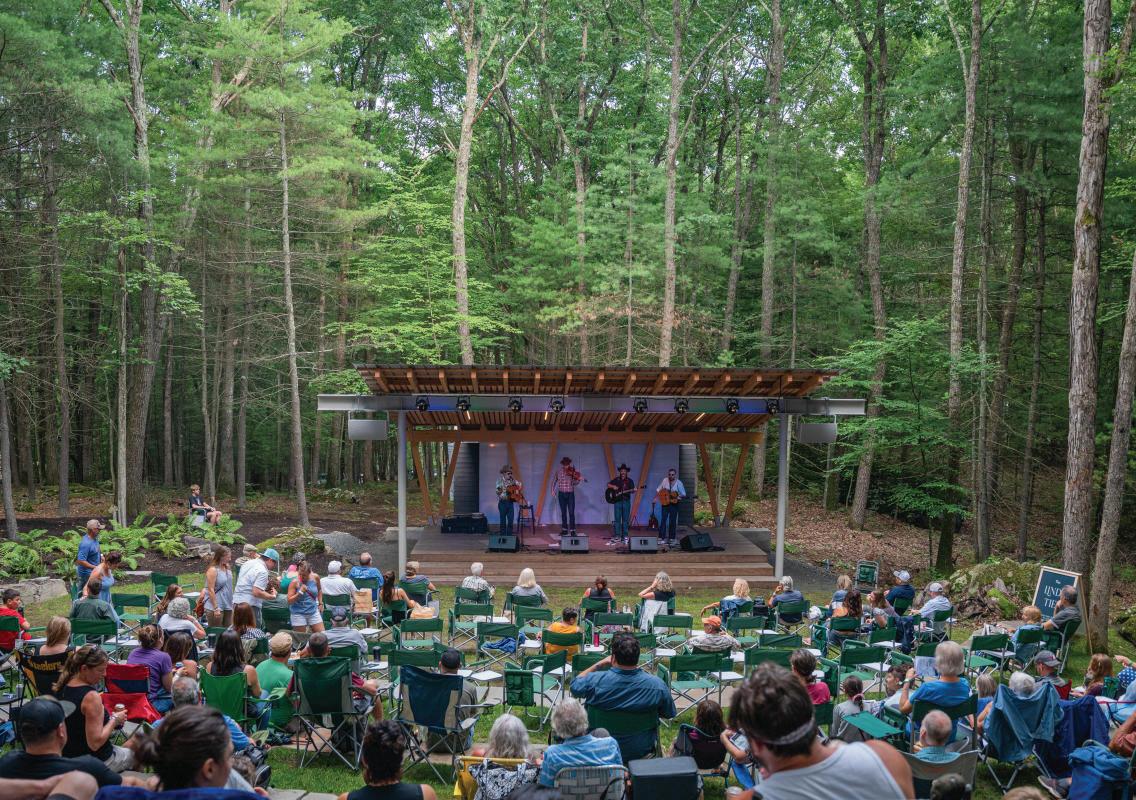
2.1.2 Construct a permanent pavilion for informal gatherings. Consider the construction of a permanent pavilion near the lake for NC State events, community use, and informal gatherings.
2.1.3 Maintain the open lawn for events. Continue to maintain and utilize the open lawn near the lake for LIVE@Lake Raleigh and other events until permanent facilities are complete.
With its unique location near Lake Raleigh, the LIVE@Lake Raleigh events draw NC State students, faculty, staff, and community members.

o BJ ec TIV e 2.2: use ar T and en T er Ta I n M en T T o P ro M oT e an I nc L us IV e se TTI ng and en VI ron M en T
Utilize art and entertainment in various forms to help champion a culture of equity, diversity, inclusion, belonging, and well-being, as set forth in NC State’s Strategic Goals.
2.2.1 Art for Everyone. Facilitate the enjoyment of the arts for all visitors by continuing to include a variety of programs, exhibits, and performances at Lake Raleigh exhibits and event spaces.
2.2.2 Temporary Art Installations. Consider temporary public art opportunities with students, faculty, and local organizations that accentuate the environment, wilderness, and biodiversity.
Providing opportunities for students to participate in and appreciate public art creates a welcoming and inclusive environment.

1.1.1 Explore opportunities with on and off campus collaborators to expand and increase the appeal of music concerts and live events.
1.1.2 Establish and enhance locations and schedules for food and mobile vendors included as part of Lake Raleigh and Centennial Campus activities.
2.1.1 Explore the construction of a permanent event venue near the lake for music events and other performances.
2.1.2 Consider the construction of a permanent pavilion near the lake for NC State events, community use, and informal gatherings.
2.1.3 Continue to maintain and utilize the open lawn near the lake for LIVE@ Lake Raleigh and other events until permanent facilities are complete.
USE ART AND ENTERTAINMENT TO PROMOTE AN INCLUSIVE SETTING/ENVIRONMENT
2.2.1 Facilitate the enjoyment of the arts for all visitors by continuing to include a variety of programs, exhibits, and performances at Lake Raleigh exhibits and event spaces.
2.2.2 Consider temporary public art opportunities with students, faculty, and local organizations that accentuate the environment, wilderness, and biodiversity.


This chapter presents general recommendations for implementing the Activate Lake Raleigh plan and the list of activation initiatives that should be prioritized for near-term implementation.
5.1 General Recommendations
5.2 Activation Priorities
Activate Lake Raleigh provides a community-led vision and roadmap to activate the Lake Raleigh area to benefit NC State students, faculty and staff, Centennial Campus residents and industry partners, and residents of the greater Raleigh community.
The leadership team for Lake Raleigh area should consider four general recommendations as they work to implement the Activate Lake Raleigh plan, which include the following:
1. Maintenance Plan: When a strategy is implemented that includes the construction or renovation of physical infrastructure, such as trails, furnishings, buildings, or water access points –include a long-term plan for how the asset will be maintained.
2. Management Plan: When a strategy is implemented that includes programming or educational resources – identify which department, group, or person will provide long-term management and staffing.
3. Implementation Advisory Group: Consider establishing a small Advisory Group composed of representatives from the NC State community. The group will meet regularly to identify and prioritize projects, and any additional resources required to implement and staff the projects or execution.
The Wild Center in Tupper Lake, New York serves as a case study for how the Lake Raleigh area can be successfully activated with a blend of science-based experiences, programs, and assets that serve the NC State and greater Raleigh communities.
The Wild Center features experiences, exhibits, and programs that are designed to open new ways to explore the relationship between humans and nature. The Center was started in 1999 with a desire to demonstrate how people can live in wild places without damaging its biodiversity. The Wild Center includes unique exhibits such as Wild Walk and Stick Work along with experiences such as canoe trips and forest music. The Center attracts visitors from across the region with over 1 million visitors between its opening in 1999 and 2017. photo, Credit: The Wild Center

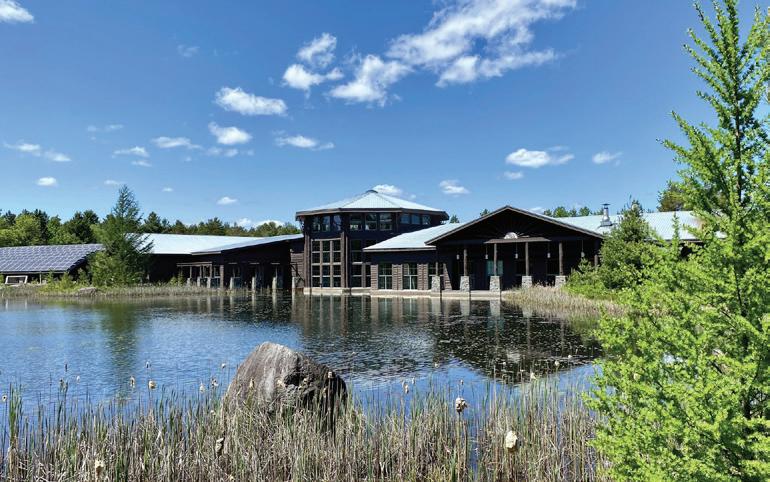

While all of the initiatives listed in the Activate Lake Raleigh plan are important, this section outlines the top activation priorities based on community input, activation benefit, and user group engagement. The 25 initiatives listed below should be considered for near-term implementation.
• Establish visual connection from The Oval to Lake Raleigh through selective tree removal or pruning.
• Complete the trail around the lake including boardwalk and observation decks.
• Establish additional community connections through programming designed to attract new users.
• Add Lake Raleigh area and Lake Raleigh Woods as a destination on existing campus wayfinding.
en VI ron M en Ta L s T e W ards HIP
• Establish volunteer groups to “adopt” and maintain trails, lake, and related amenities.
• Eradicate invasive aquatic vegetation species to the maximum extent practical.
• Assess conditions and remove floatable debris and trash from the lake and along the lakeshore regularly.
• Sustain the recreational, environmental, social, and educational benefits of the Lake Raleigh area by carefully considering development adjacent to the lake, with additional scrutiny in Lake Raleigh Woods.
• Enhance and improve disc golf course.
• Provide multiple lake accesses, destination points, and amenities for kayaking/paddling, including rentals, lockers, instruction and beginner classes, etc.
• Install tree weaves or similar to allow access to the tree canopy.
• Offer equipment and gear rentals for paddling, biking, fishing, and sailing.
• Establish a sensory/tranquility garden.
• Install new outdoor furnishings (seats, benches, etc).
• Create a hammock grove.
• Develop a collaborative space for research and related academic endeavors; e.g. a multi-story treehouse for birdwatching.
• Open dialogue with relevant University colleges and departments about how to create a living laboratory in the Lake Raleigh area.
• Open dialogue with relevant departments to explore what a fully equipped outdoor classroom space and shared teaching lab might consist of and how to best manage the space.
• Inspire innovative approaches to participatory science through living laboratory, hands-on learning, and service/volunteer opportunities.
• Install interpretive signage and educational exhibits along trails where appropriate.
ar T s + en T er Ta I n M en T
• Establish and enhance locations and schedules for food and mobile vendors included as part of Lake Raleigh and Centennial Campus activities.
• Explore the construction of a permanent event venue near the lake for music events and other performances.
• Consider the construction of a permanent pavilion near the lake for NC State events, community use, and informal gatherings.
• Maintain the open lawn and event space for LIVE@Lake Raleigh until permanent facilities are complete.
• Consider temporary public art opportunities with students, faculty, and local organizations that accentuate the environment, wilderness, and biodiversity.

